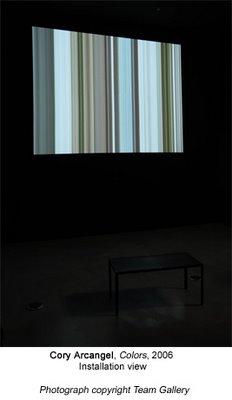View current page
45 matchs for rhizome:
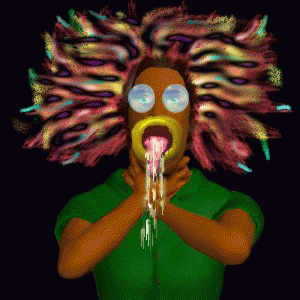
An interview with musician and animator Silicious, by Petra Cortright, commissioned by Rhizome.org, is on the Rhizome front page*. Earlier posts on Silicious are here.
I love the music of Silicious' video Georg: like slowed down Giorgio Moroder with call and response vocals, ringing telephones, etc.
Update: Just noticed that Rhizome tabbed the interview "ironic." That is way off base--this is very sincere and emotional work, and I believe Petra and others are sincerely interested in it. "Visionary," "playful," expressionistic," non-status quo," "angsty," "political," "disturbing" are the words I would use. Or "freakedelic," to use Daniel's term.
Update, 2011: The Rhizome link has been changed to http://rhizome.org/editorial/2007/jul/14/interview-with-silicious/
The following article about group blogs, blogging-as-performance, and an emerging digital aesthetic or anti-aesthetic was published in the Irish Times for July 2, 2007:
Beyond Art and Design
Haydn ShaughnessyI wonder how many artists agree with this statement. "I reached a point as a critic and as an artist when it seemed like to be a painter everyone had a studio trick that they kept to themselves to differentiate their work." So says Tom Moody, one of the Web's more influential art bloggers and practitioners.
It seems to me honest and accurate and applies not just to painting. Everywhere we turn we're being asked to differentiate ourselves, not just as artists but through what we wear and how we do our jobs. Moody is speaking though for a generation who feel liberated by new technology, for a group that has gone beyond the frustration of trying to find minor points of uniqueness. Up until a week ago his was the first blog to be exhibited as an artwork Ė at artmovingprojects in Brooklyn, New York. Artmoving projects made Moody's blog a live installation. Even if you haven't embraced blogs yet you'd be tempted to say: Wow, with or without exclamation mark! The blog as installation is yet another example of how virtual, simulated and real environments are blurring.
On his blog a few days ago Moody provided a shortlist of group art blogs (see below), the online equivalent of the cooperative studio. These groups collectively raise an important question about the aesthetics of art born digital.
"As a painter I felt there was no ground left to be broken," says Moody. "And we're faced with these other digital tools which are new and have a lot of potential but don't, we don't, have any kind of aesthetic."
A loose aesthetic for digital art is emerging though? What norms, practice, and social and visual aspirations might inform digital art? I had Tom on the phone recently chewing over that issue.
A growing number of artists are using blogs to display their work (we recently featured Chris Ashley here on Convergence Culture, an artist who blogs an image a day). The Internet allows artists to connect quickly with each other and one result of that is they create cooperative blogs, just like some choose to open cooperative galleries. But as Tom Moody points out the chemistry of cooperation can be better. There's little financial overhead and there's no sense that cooperation is a necessary evil. But here's the interesting part.
In posting to a group blog, says Moody, you make a judgment about the work you would not like to show on your own blog. [1]
Through that act you are implicitly helping to form an aesthetic. It's not that you post to the group blog work you are not identified with at all. But you are saying something about your choices.
The underlying statement is that the artist has different artistic identities. Somewhere in the judgment about where your work belongs lie unarticulated statements about the nature and purpose of digital art. This emergent theory of digital aesthetics absolutely suits the medium. The judgments are not articulated but they are out on show.
The lack of an aesthetic is not the only problem facing digital artists. Galleries are reluctant to exhibit their work because as yet there are few collectors and no secondary market. And there is a suspicion. A digital art work when reproduced on paper can be reproduced indefinitely. Old fashioned prints created by master printers were at least authenticated by a third party. The unease that galleries and collectors feel are important practicalities.
Just like conceptual art thirty years ago digital art needs bold collectors who will buy knowing that a selection of these works will grow exponentially in value. But to be attracted that far, you sense a collector needs to know there are underlying disciplines at work, purpose and coherence that is at least comparable with their previous experience, a sense that a generation of artists, rather than the odd maverick, is pushing the medium, and confidence that the practitioners are not simply going to fade away..
To get that far the artists themselves need to start articulating the kind of purpose that resonates with a sense of destiny. Many digital artists, or performance artists who use digital media to get works into print, recoil from the idea that they can game themselves up into a "movement". Nonetheless when I put it to Tom he acknowledged: "More and more. I think the artists I'm working with and collaborating with are moving in the same direction."
Another problem for the digital artist is that many of the tools of the trade were created for designers Ė Microsoft Paint [2] and Photoshop are two prime examples. Websites that showcase art made from these tools, particularly the influential Rhizome, an atheist's Bible of new media art, are to Moody's way of thinking, pushing a design aesthetic rather than an artistic one. [3] I'm not wholly sure that I agree with him, or that digital art should separate itself from design, but the point proven is that articulating the digital aesthetic is still a work in progress.
Group art blogs:
http://www.supercentral.org/wordpress/
http://doublehappiness.ilikenicethings.com/ [4]
References courtesy Tom Moody: http://www.digitalmediatree.com/tommoody/
Artmovingprojects: http://www.artmovingprojects.com/
Rhizome: http://www.rhizome.org/
MY NOTES/AFTERTHOUGHTS TO THE ABOVE:
1. I can't take credit for this line of thought. It was first articulated by Nasty Nets member Marisa Olson on her blog: "[Nasty Nets has] been a nice place for me to follow thoughts I might otherwise censor or drop, and to make and post work I'd not likely post elsewhere..." The idea that an anti-aesthetic emerges from everyone on the site doing this is something I've kicked around with various members.
2. MSPaint isn't really a program designers use, it's an amateur program that ships with every edition of Windows. Adobe Illustrator would be a better example.
3. Whoops--if I said that it's not what I meant. Rhizome is an art site. Rhizome and Eyebeam often feature projects on their reBlog pages that I consider more in the nature of design problems (robot alarm clocks that roll away from you when you try to hit snooze, to use an example from Eyebeam). But it isn't accurate to say that Rhizome "pushes a design aesthetic rather than an artistic one." If anything, it's the notions of conceptual art embodied in digital practice that I find problematic, when they take the form of what some of us have called XYZ art.
4. Not all of these blogs--or individual posts on the blogs--are based on an aesthetic of "what I don't show on my own blog." Everyone has different motivations for what and where they post and I make no claim to speak for everyone on these sites.
More on the Rhizome 2007-2008 Commissions, from the comments:
The part of your post that bothered me was where you talked about ShiftSpace. This is a great project. The trend of Web 2.0 has been to wrest order from the chaos of the early web; ShiftSpace is a project that intends to re-inject this spirit of anarchy. For example, the comment criticizing your writing ("how long has your criticism sucked") was removed from this page; ShiftSpace would allow this comment to remain on the page for other users to see. It could be read as a critique of the increasingly moderated Wikipedia, and it's attempt at "authoritativeness"; it's infused with nostalgia for the early web when people produced their own messy pages instead of buying into the myspace prefab system; it's a classic example of a "not just art" project. [...]
- anonymous (guest) 6-24-2007 7:28 pm
With much of this art the proposal is the work. Once you've come up with your sentence explaining the tech innovation and how it benefits others you're done.
[...]
The comment criticizing my writing ("how long has your criticism sucked") was fictional. [...] You assumed it was real and I deleted it--interesting.
-tom moody [6-24-2007 8:03 pm, 6-24-2007 8:13 pm]
I would agree that "the proposal is the work" if I wasn't aware of how many artists do a terrible job of writing about their work. Those sentences usually end up being a pale reflection of the work. [...]
- anonymous (guest) 6-24-2007 8:32 pm
The goals of ShiftSpace do indeed sound worthwhile and noble but I have to confess I'm not very interested in art as sociopolitical activism, especially when the success of the project is presumed in the proposal.
I'm as concerned as the next person about the constrictions of these social networking sites but feel the way to approach them is to go elsewhere, and if there's no elsewhere then lobby for more elsewhere.
It feels like a contradiction to apply for a grant to an institution so you can be an anarchist, especially when the steps of your anarchy are carefully planned out and result in another ordered system.
- tom moody 6-25-2007 8:51 am
(previous comment self-edited for tone, substance--ShiftSpace would reveal my first draft--great)
- tom moody 6-25-2007 8:53 am
More commentary on the 2007-2008 Rhizome.org commissions Considered as XYZ Art post. People aren't offering any specific examples of where the analysis fails, they're mostly just telling me to shut up.
you could also apply the XYZ method to art criticism: take artwork X, apply categorization schema Y, produce art review Z.
- anonymous (guest) 6-21-2007 3:52 pm
You could, but some specifics would help.
I'm not sure there are any categorization schema any more except the old reliable, "mere description."
- tom moody 6-21-2007 4:46 pm
Right. Then why are you using the XYZ schema to critique art? As a critical process, it is more reductionist than the creative processes that you are criticizing.
- anonymous (guest) 6-21-2007 5:12 pm
Well, we disagree, there.
I'm flattered if you think XYZ is a critical methodology, or as you say "categorization schema."
I think the point of your comments is that it would be better not to question the Rhizome commissions.
Either that or there are so many other ways of critiquing them being articulated out there that mine should be disregarded as the weakest alternative.
R--i-i-ight.
- tom moody 6-21-2007 6:02 pm
The post on the Rhizome 2007-2008 commissions as XYZ Art (reblogged here, thanks cpb) elicited the following response:
Don't see how XYZ relates solely to these types of new media projects. Painting, sculpture, photography, many mediums use a trial-error process similar to science. For instance one commonly develops a style or signature process (the algorithm), often paying big gradschool dollars for it, then alters X strokes or colors, looks at the Z surface, changes X some, then goes for the super awesome Z for the finish. - ssrAnd my reply:
That's funny, but we're not talking about a trial-error process. It's more like one application: a single transformation of something into something that "helps others."
The art world equivalent would be a conceptual art work, something like Meg Cranston's Who's Who by Size, University of California Sample, 1994, where different fabric-covered sculptural stacks (Z) represent the number of inches of shelf space (X) that a subject (Edgar Allen Poe, Elvis Presley, etc) has in a college library. The algorithm or (Y) is assigning a fabric to the subject (Anna Pavlova in ballet slipper satin, etc) and making the stacks. The work has a point, and one point only, to show intuitively that "size matters" in assessing one's historical reputation. (I got this example and some of the description from the book Deep Storage, ed. by Ingrid Schaffner and Matthias Winzen.)
Grad schools turning out cookie cutter painting is rather a different issue.
Rhizome.org 2007-2008 Commissions* Considered as XYZ Art
"once a process (i like to say algorithm) Y is set up, you can mess about trying to figure out what X you can put in to get what Z, and then what's the best Z, and then what X will give it to you..." (Paul B. Davis on the XYZ tendency in computercentric art). That tendency crosses over from the digital/new media realm (Rhizome) to by-the-numbers conceptual art in the gallery world (VVork). Common features are a distinct grammar of subject-verb-object and a noble or socially useful goal. It is especially prevalent in tech art, which tends to mimic the scientific method's successful means of getting results. Once the "experiment" is performed, voila, Art.
1.) AddArt Member Selection
by Steve Lambert with Evan Harper
AddArt is a Firefox extension (Y) which replaces advertising images on web pages (X) with art images from a curated database (Z).
2.) Ebay-Generator
by Ubermorgen.com (Alessandro Ludovico and Paolo Cirio)
Ebay-Generator (Y) will generate songs (Z) based on the public data mined from Ebay sellers and buyers (X). Users' rating, sold objects, times and frequency of transactions and other data will be automatically transformed into a structured text, which a supercollider-application will use to generate music and lyrics.
3.) ShiftSpace - An OpenSource Layer Above Any Website
by Dan Phiffer and Mushon Zer-Aviv
While the Internet's design is widely understood to be open and distributed, control over how users interact online has given us largely centralized and closed systems. ShiftSpace is an Open Source platform (Y) that attempts to subvert this trend by providing a new public space on the web. By pressing the [Shift] + [Space] keys, a ShiftSpace user can invoke a new meta layer (Z) above any web page (X) to browse and create additional interpretations, contextualizations and interventions using various authoring tools.
4.) The Wrench
by Knifeandfork (Sue Huang and Brian House)
The Wrench will recast Primo Levi's The Monkey's Wrench (X) into a mobile phone text-message exchange between participants and an artificially-intelligent agent (Z). Taking place over the course of a week, the dialogue is not pre-determined; it employs Knifeandfork's nonlinear narrative software engine (Y). The system is intended to present a convincingly human agent within a realtime plot progression. The AI will have specific, dynamic narrative goals for each interaction, designed to intertwine the lives of the character and participant through the ubiquitous yet restrictive communication channel of text-messaging.
5.) zHarmony Member Selection
by conglomco.org (Tyler Jacobsen & Kim Schnaubert)
zHarmony is an addition (Y) to Rhizome that will combine the Compatibility Matching System of online relationship services like eHarmony with Rhizome's existing database of artists (X). zHarmony will produce a unique artist profiling system that can automatically match artists with like-minded collaborators (or groups of collaborators) based on multiple points of compatibility (Z).
Borderline XYZ projects:
6.) Eavesdropping
by Jack Stockholm
Eavesdropping is a networked audio system (Y) designed for guerilla performance (Z) to raise awareness of our ambient communication in public spaces (X). This project highlights the intentionality and exhibitionism of bringing our private actions into the public sphere.
7.) VF, Virta-Flaneurazine-SL, Proposal for Clinical Study Member Selection
by Will Pappenheimer and John Freeman
Virta-Flaneurazine-SL is a potent programmable "mood changing" drug (Y) for Second Life (SL). A member of the "Wanderment" family of psychotropic drugs; when ingested it automatically causes the bearer (X) to aimlessly roam the distant lands of SL for up to a full day. As the prograchemistry takes effect, users find themselves erratically teleporting to random locations, behaving strangely, seeing digephemera and moving in circuitous paths (Z). Many users report the experience allows them to see SL freed from its limitations as a fast growing grid of investment properties.
Non XYZ projects:
8.) Phrenology
by Melanie Crean with Chris Sugrue and Paul Geluso
Phrenology will investigate the perception of space, whether real, virtual or imagined, though writings created by incarcerated women in a workshop the artist will teach at Bedford Hills Correctional Facility. The piece will consist of a series of 360 degree photographic panoramas that interconnect through text included in the environments. Viewers will be able to move through the different environments to read the women's writing in a form of spatial poem, accompanied by an experimental sound track based on the text. [a possible (Y) might be the traditional interpretative function of the artist but that doesn't count as an "algorithm"--the use of prison texts is a typical (X)]
9.) Jellotime.com
by Rafael Rozendaal
JelloTime.com will be a website with a single flash animation. You will see a green plate with a red Jello dessert. When you touch the jelly with your mouse, it "wobbles." It will shake and make a strange sound, the more you pull it, the more it will shake. I really want to emulate the feeling of jelly, something between solid and liquid. A feeling that is very familiar in real life that might seem strange on a computer screen. [not XYZ. more like just (X)]
10.) Remote Instructions
by Lee Walton
Remote Instructions is a web-central project that will utilize both the communication capabilities of the web and spectatorship of its users. From a central hub, Lee Walton will collaborate with strangers globally via the web and orchestrate a series of video performances that will take place in real cities, neighborhoods, villages and towns around the world. A Remote Instructions website will be created to host video projects and promote networking among collaborators. [too complicated to be XYZ. sounds like a lot of work, and the only person with the big picture view will be the artist]
11.) Second Life Dumpster
by eteam
In Second Life each avatar has a trash folder. Items that get deleted end up in that folder by default. The trash folder has to get emptied as often as possible, otherwise the avatars performance might diminish. But, where do deleted things end up? What are those things? Second Life Dumpster will explore these questions by starting and maintaining a public dumpster in Second Life for the duration of one year. [this is not XYZ because it is open-ended and asks questions without knowing what the answers are. it is the second of two commissions involving Second Life, the "Active Worlds of the '00s"]
Update, 2011: The Rhizome link has been changed to http://rhizome.org/editorial/2007/jun/15/rhizome-2007-08-commissions-announcement/. Please note these are elsewhere called the 2008-2009 Commissions.
Below is Paddy Johnson's review of Cory Arcangel's "...participatory culture" show at Team Gallery last year. While critical, it is ultimately respectful and merely expresses what many thought about the show but were too cautious to say for fear of jinxing the first non-sucky computer artist to break through to art world recognition. Including me, even though I felt the show was a step back to the "BitStreams" era. I'm bringing it up now because recent writing about the artist seems to be adopting a strangely defensive or belligerent tone--it's as if you have declare whether you're for or against him, and I think we need to get over this. This review was not reBlogged by Eyebeam or Rhizome, the main new media sites, which also seems like a partisan and slightly juvenile snub. The issues are worth discussing.
I have been spending a lot of time thinking about how to discuss New Media artist Cory Arcangelís new exhibition, subtractions, modifications, addenda, and other recent contributions to participatory culture at Team Gallery, and itís not the exercise in fun it usually is. Writing about my friends is great when Iíve only got compliments to bestow, but itís another ball of wax when I leave their exhibition with a mental list of artists who have done similar work.Donít get me wrong, subtractions, modifications, addenda, and other recent contributions to participatory culture, isnít entirely derivative, nor is it a bad show per say, but it does inspire a number of questions, that arenít easily resolved. Probably the strongest work in the show is Untitled Translation Exercise, a modified version of Dazed and Confused, a film by Richard Linklater, which now features the redubbed voices of Indian actors performing the screenplay in English. The original movie is a coming of age story about a group of American high schools students experiencing the anxiety, boredom, and fervor of teenage years, so Arcangelís choice to outsource the dialogue, both heightens the viewerís sense of what it means to be American, and reflects the development of new industries in the United States.
Youíd think these ideas would be enough to stamp the piece as good and be done with it, but I canít reconcile the feeling that the decision to outsource the filmís dialogue isnít entirely resolved. There are simply too many loose ends at play here. What does the work gain by outsourcing labor that has already been completed? Was it necessary to make a feature length movie? Does the filmís narrative support the alteration? These questions donít come up in Woody Allenís similarly conceived, Whatís Up Tiger Lily, a 1966 film whereby the director purchased a Japanese spy movie, removed the sound track and replaced it with his own. Clearly the two films are different, but you canít say the approach doesnít, at the very least, merit comparison.

The other video based works in the exhibition do not invite specific film references the way Untitled Translation Exercise does, but they do seem awfully close to work that has already been made. Arcangelís Colors for example, extends pixels line by line in the Dennis Hopper movie by the same name to create a moving vertical pattern reminiscent of New Media artist Jason Salavonís The Top Grossing Film of All Time 1◊1. Exhibited in 2001 at the Whitneyís exhibition Bitstreams, the artist uses the average color of each frame in the movie Titanic, and arranges them in a digital c-print to follow the narrative sequence they would have appeared in. I suspect the programs each artist wrote to create their work were difficult to execute, but unlike the work of Salavon, those with even a small amount of website construction experience will be familiar with the technique of expanding pixels, and subsequently wonít find the Arcangel manipulation all that interesting. Even without this knowledge, I imagine many viewers will still be left wondering what the point of the alteration is (other than to create a moderately attractive picture).
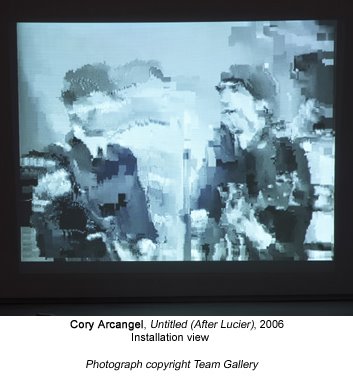
The reason these issues exist in this work, as with Untitled (After Lucier), a video loop of the Beatles on The Ed Sullivan show which compresses and loses image quality with each repetition, is that in each case, the content is subservient to the technology. And unfortunately, just as painting about painting is dull, so is tech art about tech. The thing is, Arcangel knows this, so despite the fact that some of the work in this show falls short, I have trouble believing that the exhibition is some sort of sign of things to come. Two weeks ago at Vertexlist, the artist performed pieces from his record The Bruce Springsteen ĎBorn To Runí Glockenspiel Addendum (also part of his show), and while, I canít claim to understand why the record needed to be a remix album (the artist composed five Glockenspiel pieces for the Bruce Springsteen album Born to Run, in addition to the three Springsteen had already written, matched them to the time count of the music, and removed the original music), his performance demonstrated his usual brilliance. There was a charming awkwardness to his playing, which made the piece at once humble, moving, and strangely funny. In fact, it was so enjoyable, that the thought occurred to me that while subtractions, modifications, addenda, and other recent contributions to participatory culture, isnít the best thing the artist has ever done, if he had thrown a performance into his show, nobody would have ever known the difference.
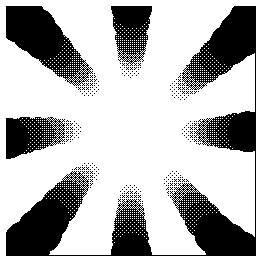
Thanks to Rhizome for reblogging* this recent sketch. I like what happened when the image resized--the center got white hot and edges became black holes. It's more of a graphic this way, but a mysterious one, I think.
Someone asked if the recent uptick here in drawings and animations was because I was showing the blog in the gallery. That hasn't started yet--end of next week. This blog is a place for my artwork and if I had more discipline I would just draw and post sound files. I post text because (a) some images don't look good adjacent to each other and it helps to have a buffer of some kind, but the buffer can't just be filler so I have to write something cogent, and (b) I'm verbose and have to talk about things (even though it means sometimes people get "insulted.") The writing helps me think through what I'm doing and ties it into a larger context of stuff I like and don't like. [/pure egotism]
Update, 2011: The Rhizome link has been changed to http://rhizome.org/editorial/2007/may/9/sketch-monochrome-gradient/.
This just popped up in the Rhizome Raw* RSS feed:
Public tribute for Jean Baudrillard on World of Warcraft.I shouldn't laugh at this, but now whenever I hear "World of Warcraft" I can't get the image out of my head of the South Park episode with the bloated pasty middle aged man with skin diseases who sits at his computer all day eating junk food and racking up obscene numbers of points killing everyone in Warcraft. Would Baudrillard have "gotten" that?
Ars Virtua will be holding a public tribute to honor the late social and political theorist Jean Baudrillard. Jean Baudrillard's criticisms and view on Simulation are influential to our discussions of the MMO.
This short program will be held on the WoW Kilrogg server, 4-5pm PDT, March 17, 2007 near Orgrimmar. Please send tell to Zuluu upon arrival in-world for the location.
Ars Virtua is a new media center and gallery located primarily in the synthetic world of Second Life. It is a new type of space that leverages the tension between 3-D rendered game space and terrestrial reality, between simulated and simulation. Ars Virtua is sponsored by the CADRE Laboratory for New Media.
*Update, 2011: The Rhizome link has been changed to http://rhizome.org/announce/events/47095/

Untitled (Lower My Bills), 2007, animated GIF. The actual, moving version is over on Nasty Nets, where I've been posting photos of Dr. Zizmor ads and other things of note. NN was recently included in "Professional Surfer,"* an online exhibit curated by Lauren Cornell for Rhizome.org.
Related: The Art of LowerMyBills.
Update, 2011: Rhizome changed the "Professional Surfer" link to http://archive.rhizome.org/exhibition/timeshares/professionalsurfer.php
Paddy Johnson on New Media: Why It Doesn't Suck (her title). MTAA on What a New Media Person Has to Do To Cross Over to the Gallery System (my title):
There are some new media artists who cross over and make it look easy. Cory Arcangel and Jennifer & Kevin McCoy come to mind. Arcangel succeeds by acting a bit like a ethnographer who travels into hacker culture and exports the bits that make sense to the art world. The McCoys succeed by addressing the older tradition of film and not letting themselves geek-out when addressing the art world.Speaking as someone with a sneakerhold in both worlds, I'd rather spend my remaining dwindling critical energy explaining the sacred mysteries of the gallery universe to Internet users than trying to tell a gallery person why a spaceship flying over an endlessly scrolling videogame landscape with the caption "lol, usenet" is funny. My sense is the former crowd is genuinely curious while the latter is boastful of its own cyber-ignorance. I will, however, take a crack at defending a Net Art 2.0 piece that I happen to really like. As Paddy describes it,
[The] Guthrie Lonergan piece MySpace Intro Playlist, a curatorial project that consists of 20 [actual, found] MySpace intro videos, inspires the same questions video art has posed to the viewer for years, ďWhy am I watching this?Ē To be honest, even as someone who uses these tools on a regular basis, I still have problems figuring out what to do with this piece. It is a cabinet of curiosities I feel I'd rather see on blogger Jason Kottkeís remaindered links, than to have it exist on the more aggrandized Rhizome Timeshares page.I'd say it's the essence of traditional video art, which deals with themes of construction of identity, guerilla theatre, acting out, and "problematizing" the medium (i.e., using it so badly it becomes self-conscious)--except there is no auteur operating the camera and doing bogus sociology. Nevertheless, as a viewer of this "artist as curator" work, as I said in an earlier post, "I feel a bit like James Stewart in Rear Window watching these normal people doing their awkward and occasionally very funny home movie bits to introduce themselves to a million total strangers. It's completely public domain but feels invasive somehow." That's the artist making me uncomfortable.
Update: In fairness to Paddy, I first encountered that piece on Lonergan's page with a link to YouTube. Some art works best "underground"--as in, you found it yourself or through a small network--and doesn't always survive an institutionally enlarged context. Cory Arcangel's Whitney Artport page is one of the few instances I can think of where an artist's anarchic sensibility completely trumped the "normalizing" effect of a museum web page.
Thanks to Eyebeam and Rhizome.org* for reblogging the recent post here on Paul Lansky. That writing's been revised a bit, including fixing one unfortunate flub: the phrase "now a kind of parallel universe to the academic camp" in the second paragraph was missing the "the," which made it sound like the post was calling "music department music" camp or kitsch. Some of it is, but not Lansky's. Some more late thoughts on Lansky's essay "The Importance of Being Digital" follow.
A possible contradiction in the essay: Lansky describes in great detail how analog recording errors can mar the pristine perfection of a digital music composition (such errors are called "artifacts," whether analog or digital). He recounts anecdotally, from the bad old days, all the steps involved in transferring a computer music piece of his to vinyl, each of which introduced artifacts. One of his philosophical selling points for digital technology is its ability to make an artifact-free copy, which is then nearly infinitely reproducible on a mass consumption level. (An aside: Lansky's irritability over intrusive sounds explains much about his music, which is remarkably smooth even at its most boisterous.)
Yet while praising the perfect copy Lansky argues for digital music's ability to exploit the "loudspeaker as instrument." In other words, the speaker is not just a window through which a pre-existing sound reality passes. Woofers and tweeters (and the creators who control them) can actively shape and define their own sonic reality. But if that is the case, why is purity of signal such a virtue? Does clarity even exist if no comparison is to be made to a pre-existing sound?
Lansky describes how analog copying procedures carry with them their own history. A grainy xerox of a smudged newspaper image of a black and white photo, for example, tells a story as much as the underlying picture. Setting aside the fact that digital production has its own artifacts, such as the non-stop yodeling of a skipping CD: this "history" can be just as much a part of that "loudspeaker reality" Lansky champions. In other words, it can serve as content to be actively used by the composer, whether through the deliberate introduction of skips and errors into the recording process, or by adding a patina of age or "period" to music, as in the distinctive mellow hum of an old tube amp: a mix of fact and fiction to be sorted out by the listener.
The point of all this being not to challenge Lansky's core arguments but simply to demote "purity of signal" in the pantheon of digital music's virtues, significantly below "ease of copying," manipulatability, and "ability to define its own reality." If clarity has a virtue at all, it is, as Lansky suggests, that it allows infinite cutting and pasting in the composition process without changing the sound in undesired ways due to accumulating artifacts. Being able to create a "richer," "fuller" sound from the rich pallette of prior recorded or previously unrecorded sounds allows the composer to more accurately trigger associations in the listener while at the same time plugging this data into the composition's imaginary patchbay of abstraction and representation.
*Update, 2011: Eyebeam reblog archives are dead. The Rhizome link has been changed to http://rhizome.org/editorial/2006/aug/12/p-lansky-club-vs-academic-electronic-music/. Please note that I authored the post, not Marisa Olson.
Thanks to Rhizome.org executive director Lauren Cornell for the generous mention of this page in her recent interview with Artkrush.* Here's an excerpt from the interview, but be forewarned that while Cornell's answer is verbatim, interviewer Paul Laster's question has been tinkered with in the interest of good-natured ****satire****. His real question can be found by clicking through to the full exchange.
Artkrush: In the early days of digital art, there was a lot of hype but little actual involvement of artists, galleries, and institutions beyond the token "net art room" in the big festivals. Then the art world took a collective step backwards with its fixation on collectors that were increasingly rich, buying paintings that were increasingly bad, by artists that were increasingly young. What has been going on in new media art during all this time? I hear the Internet is delivering streaming video these days--is that true?Cornell exercises admirable restraint throughout the interview in not saying "duh"--not so much to Laster's questions but to an art world fleeing technology cooties while continuing to bestow princely sums on sub-sub-George Condo cheeky primitivism in the name of some atavistic "cult of the hand." (Yeah, yeah, Paul Chan, Paul Pfeiffer...) In one intervew she's tasked with bringing everybody up to speed on all the cool stuff that's been happening as the world beyond the galleries continues to change.
Lauren Cornell: I actually think that interest in new media is now broader and deeper than before. The early craze around the first wave of Net art faded around the same time as the dot-com era busted. And it's true, the field did take a hit in terms of funding and support. I also think in general it was hard for people to enjoy the computer-based work of that era; viewing artwork on computers is often a psychological leap that is hard for people to make, and the Internet, which most of the works used, was quite a different, more confusing place then. In her essay "On the Vernacular Web," artist Olia Lialina describes it well, as a thin network of pages, ridden with error signs and the first kinds of online personal expression. This is a very different web and cultural moment than we have today. Now, the Internet is a mass medium, with billions of users and much more influence on culture, politics, and personal identity. The field of work that deals with the Internet or networked technologies has grown tremendously and, I believe, gained a wider relevance as digital media has become so much more common.
Update, 2011: The Artkrush link has been changed from http://beta.artkrush.com/33189 to http://artkrush.com/33189.html.
Highly recommended: video by Oliver Laric [Quicktime .mov] titled 787 Cliparts, via the Rhizome.org blog. It's 787 frames of generic cartoon line drawings (known as "clip art" from the days when people used scissors) blended together into a stop-motion animation. The flow is quite dazzling and lyrical. It recalls the Aeon Flux episode "Chronophasia," where Aeon becomes unstuck in time and transforms into hundreds of historical characters, rapidly changing costumes and hairstyles, as she walks across the room. And it's a vast improvement over the rather nauseating "scramble suit" in Richard Linklater's misbegotten A Scanner Darkly. (Prediction: 14 years from now Linklater will release a director's cut of that film restoring all the live action footage he shot, and do a big mea culpa for burying Robert Downey Jr. and all the great Philip K. Dick dialogue behind an obnoxious Photoshop filter. One cries for what that film could have been. Downey is a perfect Barris and the "sitting around the crash pad" scenes are as hilarious as they are in the book.)
Also recommended: Satellite Jockey's "Low Pressure (Sound) System Mix" [18 min / 20 mb .mp3], consisting of the geosat/bleepcentric pieces below. Gritty, sonically stimulating, often quite pretty:
1. Vladmir Ussachevsky - Wireless Fantasy
2. Kaffe Matthews - She could
3. Kid 606 - Site Specific Sound Installation
4. Alva Noto - 06-f117.tiff
5. Fennesz - Before I Leave
6. AGF - Loading
Better get it fast, SJ (aka Rick Silva) is notorious for removing great material from the web right after he posts it.
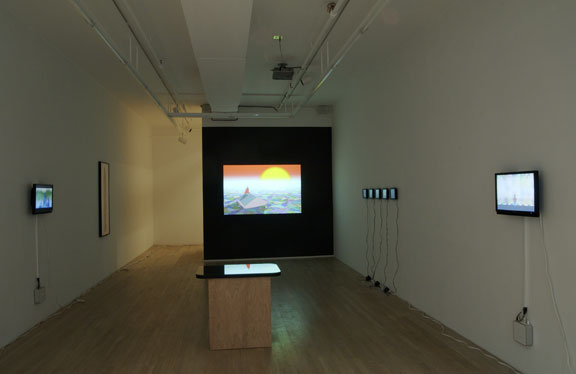
New York Times review of Michael Bell-Smith's show at Foxy Production, 617 West 27th Street (Chelsea), New York, NY, up through June 3:
Michael Bell-Smith operates in the gap between animated cartoons and painting with unusual effectiveness. His short digital loops, shown on small screens or paintinglike wall monitors, portray landscapes, cityscapes, figures and oblique social commentary. But their main concerns are color, space and light, tweaked and amplified by digital technology and restrained animation. Whether we are flying high above an endless suburbia, as in "Some Houses Have Pools," or looking at the artist as he stands in the middle of a Midtown street, as in "Self-Portrait NYC," the excitement lies in grasping the layers of the image and the way they do, or don't, change.This is a nice review but treats the gallery as a walled garden sealed off from the Internet and the street. If anyone's work could benefit from a "digital non-site" analysis it's Bell-Smith's. How much does the imagery and animation derive from gaming, website GIF wallpaper, ringtones, and upload/download culture in general and how much is invented out of whole cloth by the artist? What is the value of putting "gallery brackets" around pop culture ephemera? Is this still Pop Art? Is it relevant to mention Bell-Smith's CD of acapella hiphop hits digitally synchronized with ringtones of the same songs? That he plays in a band? Or the fact that he was recently on a panel called Net Aesthetics 2.0, that considered a gradual tectonic shift in Internet art practice? That he has a blog and is an ardent curator of Internet cult phenomena of every description, with exquisite taste in same? "The gallery" and the "art review" are still excellent places to discuss these kinds of things--particularly how they can be translated into an elegant physical space. It would be good if our top gun critics could stretch just a wee bit.
In the post-Katrina "Continue 2000," a red-caped hero stares at the setting sun from the roof of a house adrift in a flood of shimmering, patchwork color. He is going nowhere, but the sun explodes and the world turns momentarily gray, like an omen.
"Up and Away" scrolls through an encyclopedic array of panoramic horizons ó city skylines, deserts, mountains, castles, forests, oceans ó that conjure up dozens of movie genres but are actually downloaded from video games (and are so coarsely pixilated they seem Pointillist, or knitted). Now it is the viewer who goes nowhere: space is deep but never penetrated. It's like watching a deck of cards being shuffled: pick a landscape, any landscape. Mr. Bell-Smith brings new and old and static and mobile into a promising, visually enthralling alignment. ROBERTA SMITH
Last night the artist team JODI (Joan Heemskerk and Dirk Paesmans) presented their 2-channel video Max Payne Cheats Only at Electronic Arts Intermix in Chelsea. One of the earlier and still best "net artists," JODI favors anarchy, entropy, and irony over the world-bridging utopianism of much net practice; their site jodi.org famously, creatively dismantles itself (and your browser) as you use it. Max Payne Cheats Only wreaks similar havoc with the realistic "film noir" videogame Max Payne, concerning an Everyman who enters the underworld seeking Charles Bronson-style revenge after a criminal gang kills his family. The JODI version consists entirely of "cheats"--shortcuts and fragments of imagery buried in the code that are widely disseminated via (company sponsored) fan websites. Physics and perspective-flouting manipulations such as: Max walking through a wall when he gets cornered by the bad guys; Max becoming magically bulletproof--but also fun stuff like making the gangster's moll run around naked.
JODI reassembles the cheats' fragments and freaky camera angles with the manic verve of a sadistic child playing with dolls in a Dr. Caligari-like dollhouse, opting for maximum disorientation and grotesqueness. Thus, Max pounds the floor endlessly with a lead pipe, rapidly changing characters run headfirst into the same stretch of wall, the nude moll pirouettes like a ballerina in "bullet time," faces are stripped of skin and muscle leaving gaping, floating dental work. The vids meld the psychic fragmentation of Hannah Hoch's collages, the pointless headbanger repetitions of Paul McCarthy videos, and the claustrophobic worlds-within-worlds of Cronenberg's Videodrome or ExistenZ.
This work appeared a few months ago in PaceWildenstein Gallery's "Breaking and Entering: The Art of the Videogame," which exhibited it incorrectly, we learned. It's meant to be viewed flat on a wall with the audience seated; instead, the gallery displayed it on a cross-shaped wooden partition constructed for another, unshown piece (a four channel video of cars obsessively circling on grass, asphalt, and in the sky). By projecting the 2-channel Max Payne on the four-walled construction (using a couple of backup Payne DVDs to expand the video from two to four projections), PaceWildenstein in effect created a third work, which the artists, who live in Europe, didn't find out about till after the show's end. It's a shame, because the "cars circling" vids, a couple of which were shown last night, would have been impressive in a gallery space. They are repetitive and "ambient" as opposed to long and "linear" and thus more appropriate to show in a physical setting where viewers walk around and are unlikely to stand and watch for long.
A bit of drama: Right at the point in the panel last night when the artists and attendees were mulling over what PaceWildenstein could possibly have been thinking (were they sloppy, high-handed, or both?), someone (a dealer, I was told) angrily interjected from the audience that the speculation and criticisms regarding the gallery were inappropriate. "Of course they were negligent, we don't need to discuss it," he declared. Rather weird. Fun panel--thanks to Caitlin Jones for moderating and EAI and Rhizome.org for hosting this event.
An earlier post on JODI is here.
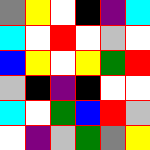
Two shows opening this week:
Tom Moody, Room Sized Animated GIFsAnd, Rhizome.org Net Art News on The GIF Show*:
artMovingProjects
Williamsburg, Brooklyn, NY
166 North 12th Street
917-301-6680
May 5 - June 25, 2006
Opening: Friday, May 5, 7:00PM - 9:00PM
Music Performance/Lecture: May 19th, 8PM
Note: gallery closed June 8-11
Animated GIFs, the tiny, blinking, often annoying image files that draw your eye to particular parts of a Web page, have been around since the Net's early days. There is a sizeable do-it-yourself culture built up around them, which now includes a second generation of Web and gallery based art using them ironically and/or proactively.
For the past several years, Moody has been drawing GIFs in a simple paint program and posting them on his blog. The gallery will project two of these pulsing, but defiantly lo-fi animations huge on opposing walls of the space. Others will be displayed on monitors scattered on the floor.
The gallery will also feature a lecture/performance by Moody where he will present some of his music. These catchy compositions, made with a combination of old computers such as the Macintosh SE as well as more current soft synths and samplers, have a punchy concision similar to his GIFs. The styles range from videogame Electro to a string quartet piece written for a softsampler. --from ArtCal
The GIF Show, an exhibition opening May 3rd, at San Franciscoís Rx Gallery, takes the pulse of what some net surfers call ĎGIF Luv,í a recent frenzy of file-sharing and creative muscle-flexing associated with GIFs (Graphic Interchange Format files). Curated by Marisa Olson in a West Coast Rhizome collaboration with Rx, the show presents GIFs and GIF-based videos, prints, readymades, and sculptures by a range of artists, including Cory Arcangel, Peter Baldes, Michael Bell-Smith, Jimpunk, Olia Lialina, Abe Linkoln, Guthrie Lonergan, Lovid, Tom Moody, Paper Rad, Paul Slocum, and Matt Smear (aka 893/umeancompetitor). GIFs have a rich cultural life on the internet and each bears specific stylistic markers. From Myspace graphics to advertising images to porn banners, and beyond, GIFs overcome resolution and bandwidth challenges in their pervasive population of the net. Animated GIFs, in particular, have evolved from a largely cinematic, cell-based form of art practice, and have more recently been incorporated in music videos and employed as stimulating narrative devices on blogs. From the flashy to the minimal, the sonic to the silent, the artists in The GIF Show demonstrate the diversity of forms to be found in GIFs, and many of them comment on the broader social life of these image files. The opening is sure to be just as lively, with music by Eats Tapes and visuals by Nate Boyce. Spread the luv! - Rhizome.orgThe MySpace page for The GIF Show has a lot of new material added.
*Update, 2011: The Rhizome link has been changed to http://rhizome.org/editorial/2006/apr/29/gifs-galore-and-more/


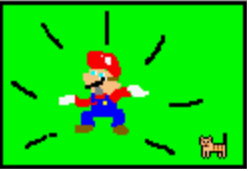
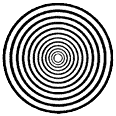

Rhizome.org Net Art News on The GIF Show*:
The GIF Show, an exhibition opening May 3rd, at San Franciscoís Rx Gallery, takes the pulse of what some net surfers call ĎGIF Luv,í a recent frenzy of file-sharing and creative muscle-flexing associated with GIFs (Graphic Interchange Format files). Curated by Marisa Olson in a West Coast Rhizome collaboration with Rx, the show presents GIFs and GIF-based videos, prints, readymades, and sculptures by a range of artists, including Cory Arcangel, Peter Baldes, Michael Bell-Smith, Jimpunk, Olia Lialina, Abe Linkoln, Guthrie Lonergan, Lovid, Tom Moody, Paper Rad, Paul Slocum, and Matt Smear (aka 893/umeancompetitor). GIFs have a rich cultural life on the internet and each bears specific stylistic markers. From Myspace graphics to advertising images to porn banners, and beyond, GIFs overcome resolution and bandwidth challenges in their pervasive population of the net. Animated GIFs, in particular, have evolved from a largely cinematic, cell-based form of art practice, and have more recently been incorporated in music videos and employed as stimulating narrative devices on blogs. From the flashy to the minimal, the sonic to the silent, the artists in The GIF Show demonstrate the diversity of forms to be found in GIFs, and many of them comment on the broader social life of these image files. The opening is sure to be just as lively, with music by Eats Tapes and visuals by Nate Boyce. Spread the luv! - Rhizome.orgAnd on the subject of GIFs, here's another plug for my solo show opening this Friday:
Tom Moody, Room Sized Animated GIFs*Update, 2011: The Rhizome link has been changed to http://rhizome.org/editorial/2006/apr/29/gifs-galore-and-more/
artMovingProjects
Williamsburg
166 North 12th Street
917-301-6680
May 5 - June 25, 2006
Opening: Friday, May 5, 7:00PM - 9:00PM
Music Performance/Lecture: May 19th, 8PM
Note: gallery closed June 8-11
Animated GIFs, the tiny, blinking, often annoying image files that draw your eye to particular parts of a Web page, have been around since the Net's early days. There is a sizeable do-it-yourself culture built up around them, which now includes a second generation of Web and gallery based art using them ironically and/or proactively.
For the past several years, Moody has been drawing GIFs in a simple paint program and posting them on his blog. The gallery will project two of these pulsing, but defiantly lo-fi animations huge on opposing walls of the space. Others will be displayed on monitors scattered on the floor.
The gallery will also feature a lecture/performance by Moody where he will present some of his music. These catchy compositions, made with a combination of old computers such as the Macintosh SE as well as more current soft synths and samplers, have a punchy concision similar to his GIFs. The styles range from videogame Electro to a string quartet piece written for a softsampler. --from ArtCal
GIF Shows
 The solo show I'm doing next month is titled "Room Sized Animated GIFs." The ArtCal listing is here (thanks to ArtCal--the listing is in RSS now will go "live" a week before the opening). The choice to use, in the title, a banal everyday computer "file extension" (.GIF) that hasn't quite risen to the level of a household word was deliberate. The point is not to be tech-elitist but rather that there is nothing more un-elite than an animated GIF, your grandmother has several of them on her homepage, but the word "GIF" is nevertheless seldom bandied about in the medieval, still-painting-centric artworld.
The solo show I'm doing next month is titled "Room Sized Animated GIFs." The ArtCal listing is here (thanks to ArtCal--the listing is in RSS now will go "live" a week before the opening). The choice to use, in the title, a banal everyday computer "file extension" (.GIF) that hasn't quite risen to the level of a household word was deliberate. The point is not to be tech-elitist but rather that there is nothing more un-elite than an animated GIF, your grandmother has several of them on her homepage, but the word "GIF" is nevertheless seldom bandied about in the medieval, still-painting-centric artworld. Another show I'm in taking the humble GIF as its theme is described on Marisa Olson's blog:
Hi, there. I've unashamedly followed the masses to Myspace, and there I've erected a page for an upcoming exhibit I'm curating. Please check it out and become our friend:Why GIFs? They're a relatively "open source" way to get ideas, in the form of moving images, out to broad audience. They are low or no cost to make, consume very little bandwidth, no one has to buy or download a proprietary player to play them. They have their own special charm, minimal in the way garage rock is minimal. Scaling them up to room size, showing them on TV screens as opposed to computer monitors, exhibiting individual frames in a grid, are ways to inject this aesthetic into physical space, which has its own demands, limitations, and pleasures.
http://www.myspace.com/gifshow
The show is called The Gif Show (I briefly considered Meet the Giffords, Meet the Giffordz, Gif Starz, and Choosy Moms Choose GIF). It opens May 3, at San Francisco's beloved RX Gallery, and is co-presented by Rhizome. The artists are Cory Arcangel, Peter Baldes, Michael Bell-Smith, Jimpunk, Olia Lialina, Abe Linkoln, Guthrie Lonergan, Lovid, Tom Moody, Paper Rad, Paul Slocum, and Matt Smear (aka 893/umeancompetitor). Everyone's showing GIFs, and some are also showing videos, works on paper, sound, and other cool related stuff. Together, their work shows the diversity of forms to be found in GIFs, and many of them comment on the broader social life of these image files.
Hence the Myspace page... GIFs grow, breed, and comingle sparklingly on Myspace. Please come be our neighbor, there, and help us spread the word about the show. (More curatorial & opening party details to come, here, in a bit.)
posted by Marisa S. Olson at 12:01
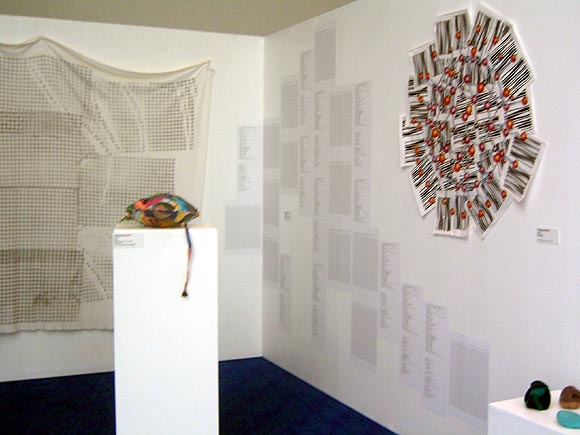
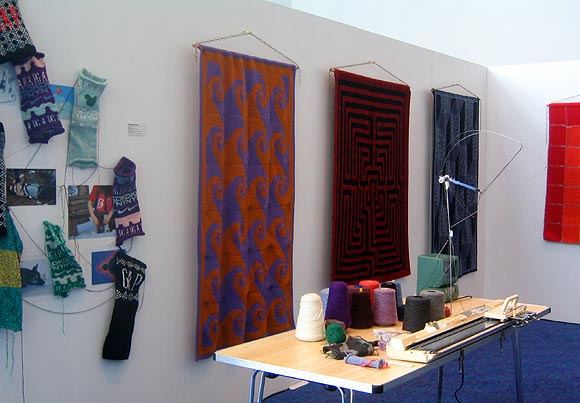
Finally got some pics of the "Fuzzy Logic" show from summer 2005, in Manchester, UK, curated by Jackie Passmore and Michael Connor. A million thanks to Cat Mazza for these photos. The show was discussed a bit here (scroll way down). The top photo depicts Cory Arcangel's Infinite Fill Blanket, Peter Coffin's "wall-based prints bridging ASCII art and knitting patterns," a LoVid soft sound sculpture on the pedestal, my Fuzzyball paper piece upper right, and Claire Irving's mathematical knitting in the foreground. The bottom photo shows Cat Mazza's logoknit pieces and her knitting machine, and Woolly Thoughts' Mathematical Afghans.
current blog page / main site
Missed the Rhizome Net Aesthetics 2.0 panel in Chelsea a couple of nights ago because I had to w*rk. Too bad--really wanted to go. MTAA has a report. The distinction between the early vernacular web and the current more "regulated" web laid out in in Olia Lialina's article here serves as a good background for understanding the shift from net art 1.0 to version 2.0. Essentially it's the world of home pages, links, and artist-scientists vs the world of blogs, Google, and fast delivery of every imaginable kind of content (except the gallerygoing kind), with artists, scientists, and artist-scientists struggling to make sense of it. I have also pontificated on it, though not in product release terms. Another distinction I would make is between the anecdotal ('70s conceptualism in web form--what Sally McKay has called "long-loading, find-the-place-to-click-me narratives packed with theoretically correct reference to the body or lack thereof") and the purely experiential (entertainingly transgressive images, music, and video produced in a collaboration-friendly, peer to peer, non-Industry environment; deliberate confusion between professional and amateur [the vernacular thankfully hasn't gone away]; better sound and pictures generally) that broadband and googling makes possible.
Update: Sal Randolph has a report on the panel at Rhizome.org.*
Update, 2011: The Rhizome link has been changed to http://rhizome.org/discuss/view/20235/ (scroll down to Randolph's comment).
2005 Internet Top Ten: Special Blogosphere Edition.
Originally posted on Michael Bell-Smith's and Cory Arcangel's Year in the Internet 2005 page. Already started revising it (see below).
SCREENFULL. This blog is now an archived project but what a great run it had. Audiovisual graffiti, deconstruction as Xtreme Sports, internet addiction as a generative principle.
RIP del.ico.us? 2005 saw this link community's rapid rise to stardom and immediate fall into the sweaty embrace of Yahoo! Will the art/geek spirit survive?
Represent or die. Lots of great quirky and f-ed up videos: the flagship del.icio.us channel (for DTV) hopefully will not be turned by Yahoo! into internet MTV, with Quicktime clips of reality shows and beach contests.
Paper Rad Info. Their blog. Prediction: because it's very easy to update it could eclipse their main page. Mine sort of did.
jenghizkhan (John Parker) live at The Front Room. Not a blog; just wanted to mention it. Sub-Troggs, Sub-Stooges fuzzbox-grungy Monomachine and circuit-bent Casio performance clocks in at 33 minutes; chatty audience tries to see if it can make more noise.
Steve Gilliard: the most razor-tongued sunny optimist on the Net. Indispensable political commentary.
WFMU's Beware of the Blog. NY area cult radio station's in-depth music (and everything else) coverage thrives in blog form. One of my favorite past FMU djs returns with a fine conversational blog style: Rise, William Berger, rise.
Rhizome.org. Another welcome addition to the (re)blog world--hopefully they'll start archiving front page content and add comments in the new year.
Other great blogs that have launched or gone into high gear in the last year: Cory Arcangel, Paul Slocum, Michael Bell-Smith.
Flag on the Moon. Blog of Jack Masters, of castlezzt fame. The post specifically linked to, "1/30th of my pictures directory, in chronological order," has been
A few months back I asked some questions* about how "tracker music" differed from early breakbeat hardcore and sequencer-based music generally, and I've still been somewhat confused. This post by Marius Watz, which Marisa Olson recently reblogged on Rhizome**, helped me quite a bit.
The arcane art of tracking takes what I like to think of as a hackerís approach to making music. The interface is primarily numeric, notes are entered via the keyboard, length, parameters, effects are often entered in hexadecimal notation, and code flies across the screen as if you were looking at the opening credits of The Matrix. Whatís not to like?*My questions from last April were: "I'm still curious (and googling) about the interrelationship of the Atari demoscene, amigatrackers, and early rave and 'ardkore. How much was hobbyist/cultist vs real club/dancefloor breakthroughs? Also how much was actually hacked and/or open source vs just using the products companies were selling? Then or now? From the wiki article it sounds like the Akai and the tracker software were inseparable 50/50 partners in defining the 'tracker' sound. Is that the same thing as 'classic' breakbeat rave or breakbeat techno? The article makes 'tracker' music sound like a cheesy variant--did that happen later or was tracker music always the music of hobbyists/Atari cultists? Finally, is the 'tracker scene' mainly a European thing?"
Kuro5hin has a good article and how-to on cutting up breakbeats with tracking. It lists possible software (such as Renoise) and gives a step-by-step breakdown of how to go about murdering the Amen Break (the biggest drumíníbass break of all timeÖ) For more insights into the origin of tracking culture, Salon.com has an article [from 1999 -ed] called MOD Love.
The Salon.com article points out that the analogy that tracking is to music what code is to software is a bit of an overstatement. Tracking, which involves writing notes and effects in hexadecimal code, is still much like sequencing. Its true significance seems to stem from the fact that tracking started as a DIY culture, by kids who had no access to professional equipment (and frequently, no musical training). But tracking also allows a mechanical approach to music that makes it attractive to practitioners of drumíníbass, breakcore, digital hardcore or plain old noise.
I've concluded that the scenes were completely separate in the late 80s/early 90s: tracking was the domain of hackers making mostly chiptunes or cheesy rave tracks, while Rob Playford, A Guy Called Gerald and other mainstays of early breakbeat and jungle were using primordial versions of programs like Logic, hardware sequencers, and more pricy (?) samplers. What's happened in the last few years is a late merger of the two styles, with trackers being used to trigger samples in very fast "jungle-like" music. In the earlier thread we had some miscommunication but I think I'm clear on this now.
**Update, 2011: The Rhizome link has been changed to http://rhizome.org/editorial/2005/nov/26/the-arcane-art-of-tracking-vs-the-amen-break/
Thanks to Robert Huffman at the Modern Theory & Contemporary Criticism forum on Myspace for his photo- and gif-annotated version of the Rhizome.org interview [dead link--see below] Cory Arcangel did with me. Robert also reBlogged the item on his blog SPACEprogram. A couple of late corrections to the interview:
Digital Media Tree is the brainchild of Jim Bassett, who wrote the software and has been the low-key, creative, officially-unofficial webmaster sinceI said 2000 in the interview; I knew that Jim, drat fink, and some other Tree-ers started blogging earlier (in the first Blogger era) but couldn't find any '99 posts until Alex Wilson reminded me that his Arboretum, covering his travels in the Central Park outback (among many other things), started in December of that year. Another minor bug in the interview was this paragraph:20001999. It is a blog collective and quite active, with all of us commenting on each other's pages and posting to public and private group pages. My invitation to join the group came from artist Bill Schwarz, who has a page at www.digitalmediatree.com/schwarz/. There are features at the Tree at I haven't found in other blog packages, such as the ease of configuring pages with "use your own html" options, and the ability to spin off an infinite series of customized pages, as blogs or fixed pages. I'm too lazy to learn CSS, but actually prefer my page's under-designed html look.
In my college DJ years I was airing Can, Ralf and Florian, Tony Williams Lifetime, Iggy Pop's The Idiot, etc. My jaw dropped, in the early '90s, when I first heard [that] breakbeat 'ardkore rave stuff. I couldn't believe how good it was--it was like all my influences grew up (and sped up).I left out the "that."
Update: New Link to Cory's interview with me.
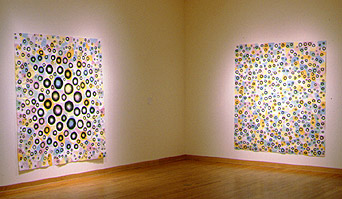 An excerpt from the interview Cory Arcangel did with me at Rhizome.org [dead link - see below]:
An excerpt from the interview Cory Arcangel did with me at Rhizome.org [dead link - see below]: "The computer still has the shock of the new, or the shock of the bad in some cases. Art world folks know painting, photo, and printmaking lore, but are less secure--myself included--knowing what constitutes talent on the computer as opposed to some easy-to-do technical trick. I thought because everyone had Paint or the equivalent on their computer and had at least made a mark or spritzed the spraycan, they could see that I was doing something more ambitious with it. I was thinking of this guy in New Mexico who made perfect perspective drawings using an Etch a Sketch. If I could draw La Femme Nikita from scratch on this toy program and actually have people (well, guys) say she's hot, then a landmark would be achieved for both Paintbrush and the computer. The problem is I drew her so realistically people assumed I was running a photo though a pixelating filter.
"When I talk about craft on the blog, just to make it clear, I'm not talking about drawing ability but things like mosaics and needlepoints that relate to the computer on a much more fundamental image-making level, the grid level. I love the cross-stitch patterns and beadwork you can find online based on MSPaint drawings. In the late '90s I was impressed by the writing of cyberfeminist Sadie Plant, who opened up for me a whole organic, non-analytical way of looking at computation. She traces digital equipment back to one of its earliest uses, as punchcards for looms, and talks of the internet as a distributed collaborative artwork akin to traditionally feminine craft projects At the time I was drawing and printing hundreds of spheres at work and bringing them home, cutting polygons around them, and then taping the polygons back together in enormous paper quilts. In my press release for the Derek Eller show we called it 'corporate tramp art.'"
Update: New Link to Cory's interview with me.
Cory Arcangel did an interview with me, published today at Rhizome.org [dead link - see below]. Thanks to him for the good back-and-forth, once I got my rather long-winded biographical reminiscing out of the way, and Marisa Olson for her editing. (Update: Marisa just reposted the lead-in to the interview--newsGRIST's reblogging of Rhizome's original post.)*
It was great to talk about music with Cory, whose work I really like. The 8-Bit Construction Set LP--which he made with the BEIGE crew--still gets props, most recently in an article in Wired. Also "Rudy Tardy and the Slowes," his solo music that I posted here a while back, continues to be listened and linked to, just this month by an Italian site called neural.it. We also talked about visual art--Chris Ashley found a good excerpt that I will probably post as a teaser; see the comments for now. In fact, I'll probably end up putting up goodly chunks of the interview here as I continue to have second thoughts and/or run out of new things to say.
At the end of the interview we discussed what it means for an artist to be "all over the place," i. e., not just sitting in the studio turning out objects in that same signature style. I gave the best answer I could--it's tough. I understand the benefits of that kind of forced discipline, and go in and out of periods of Tim Hawkinson-like focus myself, but I hate that it's the only measure of commitment or worth as an artist. One hope I had in starting the blog was that the various diverse activities documented here could be seen as feeding into some kind of overall artistic sensibility. But for all the lip service paid to the idea of cross-disciplinary practice by curators, etc., it's still viewed with skepticism. In the art world's collective unconscious, the prime model is still a romantic primitive like Albert Pinkham Ryder, painting all day and sleeping on the streets at night in a rolled up carpet. And doing nothing else.
reposted with more verbiage...and ranting
Update: New Link to Cory's interview with me.
*Update 2: Marisa Olson's lead-in is now at http://rhizome.org/editorial/2005/oct/31/tom-moody-chats-w-cory-arcangel/
I've been avoiding iTunes as a consumer and a producer with only the vaguest thought for why it rubbed me the wrong way, other than (i) the evil record companies haven't shut it down so it must be bad, (ii) $1.00 a song seems way too high for a compressed file when more good ones than you could ever listen to can be found free on the web, (iii) fads suck and Apple, after being the cool company for so many years, is starting to suck, and (iv) headphones for recreational listening are bad for your long-term hearing.
Thanks to Francis Hwang for linking to the musicians' rights organization Downhill Battle, which has this page up explaining exactly what's wrong with iTunes and proposing a much more wholesome scheme called "voluntary collective licensing." One good reason for avoiding the iTunes empire is
Despite huge new efficiencies created by internet distribution--no CDs to make, no distributors to store and ship them, no CD stores to build and run--artists receive the same pathetic cut [as they do from their exploitative record contracts]. That is the disaster of iTunes. Instead of using this new medium to empower musicians and their fans, it helps the record industry cartel perpetuate the exploitation. Apple might say it's not their fault: after all, they didn't write the unfair record contracts. But when Apple supports and profits from an obviously unfair system, while telling customers that it's "fair to the artists," they are just as guilty. [Per Downhill Battle, Apple recently removed the claim that iTunes is "fair to the artists" from their website.]Hwang recently had a run-in with the not-so-benevolent Apple when he put a parody iPod up for sale on eBay. Referencing the infamous early copyright debacle where rich rockers U2 went after indies Negativland and bled them dry from legal fees for no apparent reason other than because they could, Hwang sold an actual, functioning, repackaged-but-not-otherwise-altered iPod loaded with eight Negativland albums, "to get you started in your subversive listening habits." This was clearly an art project, prank, legitimate act of protest, or what have you; proceeds were to go the the aforementioned Downhill Battle.
The humorless Apple predictably stopped the eBay sale. Hwang received an email from the online auctioneer telling him "We would like to let you know that we removed your listing: 2290680118 Unauthorized iPod U2 vs. Negativland Special Edition because an intellectual property rights owner notified us, under penalty of perjury, that your listing infringes the rights owner's copyright, trademark, or other rights." (Perjury means lying under oath. I assume this means Apple had to swear the infringement claim was valid. It could be clearer.)
Hwang's project is further explained in Rhizome's Net Art News, which perhaps goes a tad light on the heavies ("Apple contributed to the poetry of the object" by stopping the sale?), and on this page of Hwang's. His first iPod is no longer for sale, but a second version is included in Negativland's current show, which I haven't seen, at Gigantic Art Space in NYC.
Shoutbacks--Thanks for the shouts this week from:
Tim at Travelers Diagram, whose lists of books spotted on New York subways I always enjoy, along with the other diverse and entertaining finds on his weblog, such as this story about war criminal Henry Kissinger reading about his own outrageously advanced pot belly in the New York Post. Congratulations on your wedding, Tim!
paul at dataisnature, who talked about my molecule-cum-product-box installations (been thinking about doing more of them). I look forward to perusing his archives and looking at more pieces like this one, speaking of fanciful molecular forms.
Rob Myers for his post on Swarm (but there's no scanning or retouching in that work--just printing and overprinting, and cutting with an X-acto). In this interview he talks about his admiration for the conceptualist outfit Art & Language and his fondness for remixing others' work. Yet the pieces in his San Jose series and the Smileys series are quite joyful and individualistic, not just an illustration of theory--or perhaps it would be more accurate to say they're their own semiotic theory in a tangible, pleasurable form. Examples from "San Jose" are below--he thinks it's his "weakest work" because it's not directly influenced by anyone else, but maybe he's just being modest or ironic. I would describe these as biomorphic tags done corporate logo style, and would like to see them in a show with Ryan McGinness and Anton Vidokle, who have also done hard-edged logo-like imagery. They're really nice:

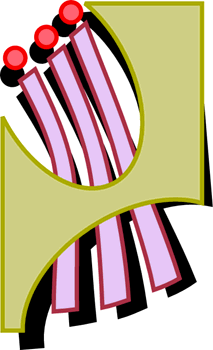
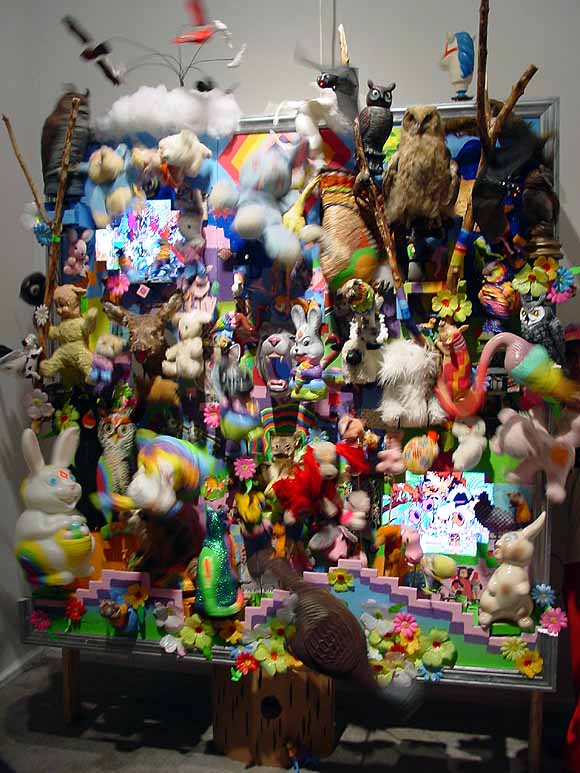
From the press release for the exhibition RHIZOME ArtBase 101* (Rhizome.org at the New Museum, June 23 - September 10, 2005): "In extreme animalz: the movie: part 1 (2005) by U.S.-based collective Paper Rad and Pittsburgh-based artist Matt Barton, .GIF files of animals, sourced through Google's Image Search, are woven into a digital tapestry that is mirrored by a surrounding cluster of mechanized stuffed animals." [And taxidermied road kill (see detail below). The blurriness in the above photo is from the animals spinning and bobbing on cams and rotors like a carnival booth in the late stages of amphetamine psychosis. The aforementioned .GIFs are on video screens mingled in among the animals. --tm]

More from the press release: "In Dot Matrix Synth (2003), American artist Paul Slocum reprogrammed a dot matrix printer so that it plays electronic notes in accordance with different printing frequencies." [Couldn't hear this over the opening crowd noise, but it was printing away when I walked up. Yes, it makes music and still prints. --tm]
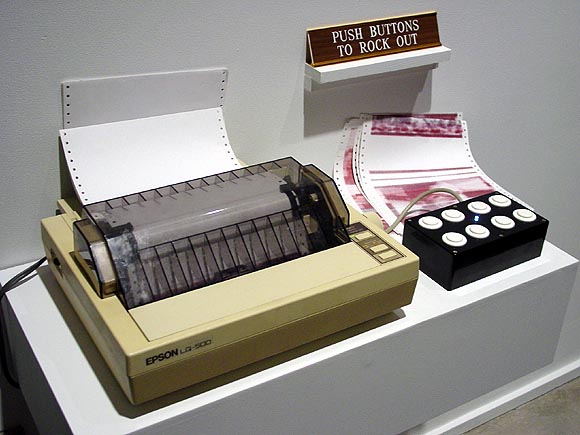
*Update, 2011: The Rhizome link has been changed to http://archive.rhizome.org:8080/exhibition/artbase101/
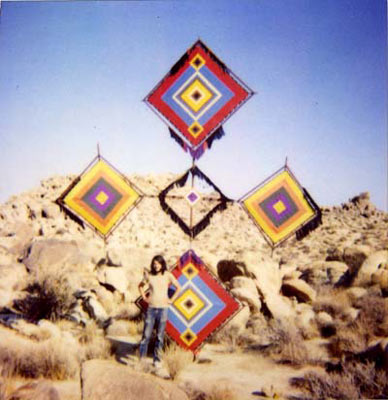
Been thinking about hippies lately. Not just me, the art world is going through (yet another interminable) hippie phase, inspired by "the rise of the new art collectives" and/or the salesmanship of gallerists Daniel Reich and John Connelly--some cynics say they're one and the same phenomenon. (Not saying I'm saying that, but have had a couple of impassioned discussions with people in the last week who think the 2003 Holland Cotter article identifying art collectives as a national trend was either part of an elaborate marketing scheme or a lazy writer being handed a package by a dealer--"collectives" being a more or less constant, short-lived byproduct of kids meeting up in art school.)
Christopher Hitchens, in a recent diatribe about how much the left sucks, sought to condense the whole 60s counterculture down to one image of lame misguidedness: the commune 20-somethings in Easy Rider scattering seed in the dusty furrows of the land where they have to come to "make their stand." That socks it home all right--but doesn't give the film credit for being a smart and subtle critique of the very phenomenon it was selling: right after the shot of the barefoot seed-sowers, the camera pulls back and lingers over a western landscape that is mountainous and dry, dry, dry. Just as you're thinking that, Peter Fonda says, "Do you get much rain out here?" (And then later, incongruously, opines "They're gonna make it.")
The photo above is a work from Justin Samson's current show at John Connelly Presents. I assume this is a sculpture Samson made and am guessing it was for a residency at Andrea Zittel's Joshua Tree, CA, studio/project space High Desert Test Sites, so no actual hippies were involved. Below is the Mondo Mondo Trading Post, which Matt Savitsky and Kevin McGarry erect outside strip mall coffee shops, bookstores and the like to trade Perler bead souvenirs. Again, no bonafide tuning in, turning on, or dropping out is occurring--day jobs are preserved while we are reminded of our buckskin past, just as in Little House on the Prairie reruns. I actually like McGarry's and Savitsky's project, and I like the Samson photo, but am just wondering--what is it with artists and hippies these days? Is it yet another media critique? (They loved the 60s back in the 80s too--loved to make fun of them--as in Kenny Scharf's sardonic black light rooms and Halley's Day Glo paints.) Is it some unironic yearning for "the real" amongst all the Starbucks simu-culture? A little of both? Can those be mixed?
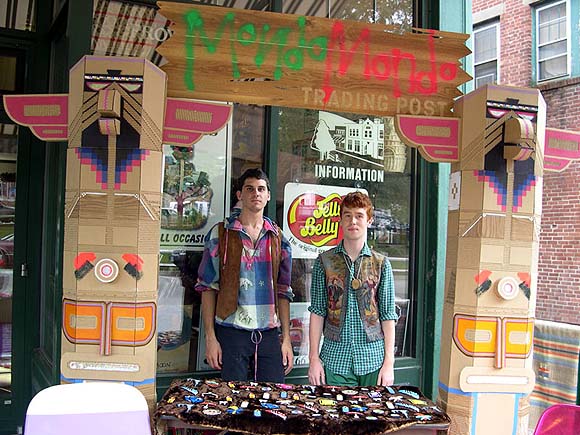
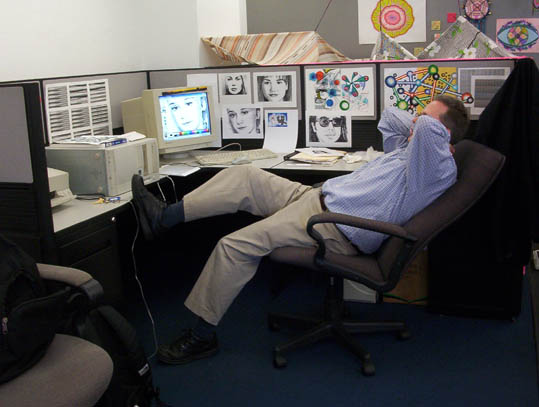
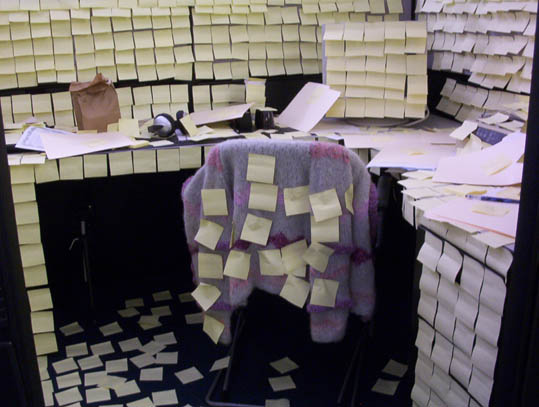
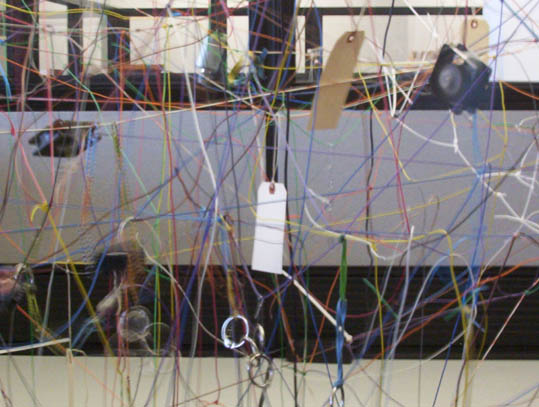
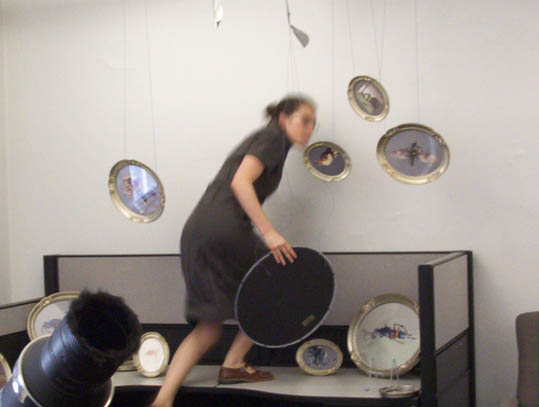
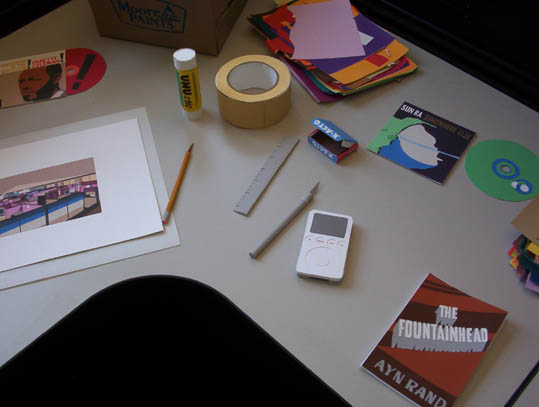
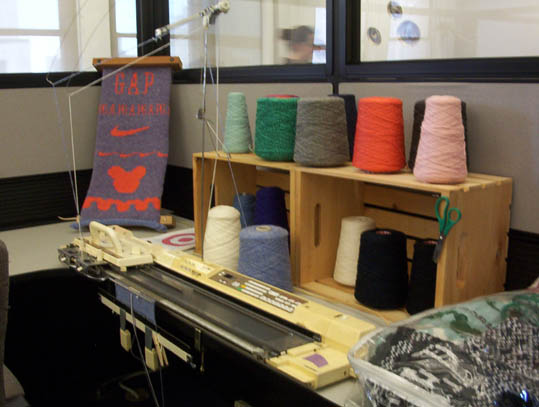
Some good photos from the ART@><*WORK show* taken by Chris Ashley, who was in town from the West Coast to be on the Blogging & the Arts Panel at the New Museum. Top to bottom: (1) dude working hard in foreground cubicle with details from Erika Somogyi/Evan Greenfield cube behind, (2) Elana Langer's work area, (3) Douglas Repetto/LoVid's cube, (4) Langer deals with falling Irene Moons, (5) Brian Alfred--the whole array including the tools is made out of Color Aid paper, (6) Cat Mazza's cube. I like the way Ashley just plunged in there with his digital camera, nailed the spirit of the show, and had it all up on his weblog the next day (with accompanying text). This should be the model for art writing/reportage: artist with camera and clue documents on the fly as opposed to waiting around for some old-media wizard to dignify your show in print months after the fact. (A concomitant aspect being that you would then link to said reportage on your "hompy"--what they call homepages in Korea--as opposed to whining that you never get ink, which would have the side benefit of increasing the standing of the artist/documenter and eventuallly breaking the deadly cult of stultified expertise that ruled art in the last century.)
*Update, 2011: The Rhizome link has been changed to http://rhizome.org/editorial/2005/may/18/how-to-succeed-in-the-arts-by-really-trying/
Rhizome.org's Net Art News has a nice writeup on the ART@><*WORK show. Lauren Cornell begins her piece with the following hackle-raising anecdote:
A New York gallerist once took the wind out of my sails by telling me "If you're not trying to make it to the top in this town, then GET OUT OF THE WAY!" Umm, what top? What way?Let's briefly answer those questions. The top: Gagosian, Matthew Marks, PaceWildenstein. The way: art school with influential 70s/80s figure on faculty, show with Connelly or Reich, inclusion in the Whitney, move to the Boesky/Rosen stratum and if you survive midcareer hell thence to canonization and high-level commerce at the aforementioned "top" galleries. That's it, folks!
Speaking of alternatives, Joy Garnett has a report on the second Blogging & the Arts panel here. Fun event but too sparsely attended! I guess everyone was busy making it to the top. Thanks to Francis Hwang for organizing these events (there'll be more), also under the auspices of Rhizome.org at the New Museum.
Update, 2011: The Rhizome link has been changed to http://rhizome.org/editorial/2005/may/18/how-to-succeed-in-the-arts-by-really-trying/
Chris Ashley, The Infinite Line: List, 2005, HTML, 620 x 500 pixels
Blogging and the Arts Panel 2
Rhizome.org at the New Museum is having its second Blogging and the Arts Panel tomorrow night, Tuesday, May 17. You may recall the first panel, which yours truly was on and which got written up ad infinitum...on this page. Here's the prospectus for tomorrow's:
Rhizome.org Director of Technology Francis Hwang will lead a panel discussion on Blogging and the Arts. This panel, the second in a series hosted by Rhizome.org, includes painter and web-artist Chris Ashley, painter Joy Garnett, artist and programmer Patrick May, and writer Liza Sabater. The discussion will address issues such as ways that artists are using blogs to distribute their own work, and the influence of blogging culture on political issues of interest to those in the arts.Chris Ashley's work has been talked about on this weblog quite a bit; it's nice to see him getting over here to the east coast for some meat space confabbing. His work was described by some internet soundbite-meister as "Mondrian for your browser," and that's perfectly good but omits a few art historical steps and much of the innovation, as described here and here.
About Rhizome.org
Founded in 1996, Rhizome.org is an internet-based platform for the global new media arts community. Through programs such as publications, online discussion, art commissions, and archiving, it supports the creation, presentation, discussion, and preservation of contemporary art using new technologies. Since 2003, Rhizome.org has been affiliated with the New Museum of Contemporary Art.
Still More Damn Metablogging
Just reading a New York Times article (linked to by Bill) that talks about how blogs are changing the design world because bloggers write from passion and editors and other trendspotters increasingly rely on them to suss out the new.* This hasn't happened in the art world, because galleries still don't know what blogs are. (Print magazines are figuring it out and thanks again to AinA.) One of the themes of the Rhizome "Blogging and the Arts" panel in Nov. at the New Museum was whether this thickheadedness on the part of art spaces was volitional. Most of the audience for that panel, I'd guess, came from the new media community, comprising folks making computer, internet, video, and multimedia art that is exciting and increasingly relevant as the world becomes more wired, but hard to commodify in the same way that galleries package and sell non-virtual artists.
Many in this cyber-community think the internet's openness and transparency threatens the gallery's traditional business of "creating the appearance of rarity or scarcity of objects in order to market them for high prices to an elite," as someone said that night. Yet at the same time the new media-ers ultimately want that gallery sanction--for the art world to say that what they do is not only art, but great art. My own response is there is no conspiracy, that the gallery world has certain habits of practice, which up till a few years ago included putting up shows, mailing out invitations, getting critics in, xeroxing the critics' clippings and mailing them to collectors, etc. but now includes dealing with the baffling and ever-changing world of websites and like it or not, blogs. Most overworked, underpaid gallery worker ants don't have the time, money, or energy to deal with this layer.
Having said all that, it's annoying that galleries don't acknowledge blog writing and still privilege King Print. I admit I only recently added blog references and hyperlinks to my personal resume, and it's going to be a pain to keep track of them as URLs change or heaven forbid disappear. But I think it's an important step. From the galleries' perspective, legitimation or verification of artists ought to be a two way street, or packet exchange or whatever: they rely on known critics to build the case for work, but they also endorse lesser-known critics by including them in their artists' clipping files. If an up-and-coming critic says something perceptive about a show that the mainstream media mavens missed, the gallery helps spread the word that that writer has a clue by listing their writing on the bio. Thus begins a cycle of mutual critical reinforcement, what the cynical might call a circle jerk, but nevertheless potentially scene-defining.
*The article goes on to talk about how manufacturers corrupt this process by giving bloggers freebies in exchange for plugs, but the art world isn't even to stage one of bloggers mattering yet.
More Damned Metablogging
Many thanks to Raphael Rubinstein for his nice piece on art blogs in the January 2005 Art in America, and for tossing this page into the mix. Dan at Iconoduel, another tossee, posted searchable text here, and still another, Joy Garnett at NEWSgrist, put up a scan. Garnett related the AinA piece to the recent Rhizome.org panel on art blogs I and other bloggers participated in, and also a research paper titled "Art Blogs: Why Such a Timid Emergence?" by Marie Omann, a masters degree student in Design, Communication and Media at the IT University of Copenhagen, which is published in .PDF form on T.Whid's and M.River's blog.
The panel and the paper tended to concentrate on how practicing artists use blogs, while Rubinstein focused more on the growing field of blog-style art journalism. Omann imposed especially tight criteria for her research subjects, requiring that the blogs be written by artists in their role as artists, have artistic content, and be updated daily. She then triangulated this activity within current sociological and media theory about the internet and its budding communities.
In brief, Omann mostly shrugs off the old-school Marxist view of Modernity as a community-destroying blight and posits art blogs as an example of "liberated communities," that is, "sparsely knit and territorially unbound communities based on individual choices." (Think fan clubs and terrorist cells.) Before the Internet, these "geographically dispersed social networks" already existed in our highly mobile, wired society--even participation in a biological family unit is increasingly seen as voluntary when its members live in different cities.
As for how well blogging fits into all this, let's just say my two cents were quoted at length so of course I think her arguments are great. But as I told Omann in a thank you email, she possibly oversold the idea of community within the world of visual art online self-publishing. Fault lines exist within this global village that are actually gaping, sulphurous chasms patched over with hopeful cyber-cement. Here are just a few of the divisions:
Print journalism (and its online variants) vs blogs. A subject of endless, mostly angry fascination among the art-journo-bloggers, and while Rubinstein has extended the olive branch of reciprocal fascination, it should probably be greeted with haughty skepticism. Just kidding, of course.
New York vs everywhere else. Another subject of endless fascination outside New York, but tedious to read. The discourse needs to rise above the level of lame us vs them conspiracy theories.
Artists vs non-artists. Shop talk steers the bus but others are welcome to listen in and back seat drive, assuming that's OK with James Elkins.
Gallery art vs new media art. Can anyone argue across this divide? Will the former please pay attention to the latter and will the latter please stop obsessing about not being paid attention to?
Blogging about art vs other stuff. It's silly to limit yourself to one subject in a medium that can tie you into any discourse at the click of a hyperlink.
This page promises to work hard to widen all these nascent, still largely unspoken rifts within the so-called community of so-called art blogs. In a friendly way.
Update: edited slightly to clarify that "NY vs Everywhere Else" whining is tedious universally, not just to New Yorkers. I hated it long before I lived here.
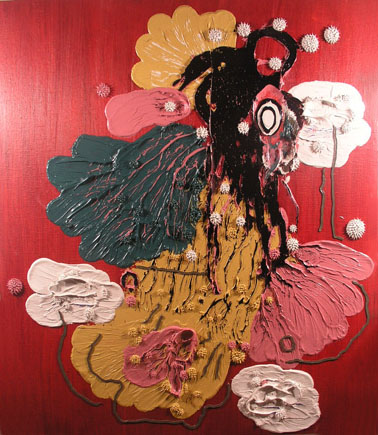
One recurring theme in the Rhizome.org blog panel tonight that is contradicted by Dennis Hollingsworth's blog: the idea that the art world always seeks to mystify and restrict access to the creator's output. Hollingsworth shows with Nicole Klagsbrun in New York and his work gets out there, as in, it's collected. He's a terrific painter and I thoroughly enjoyed the last show I saw at Klagsbrun. Complex stuff in the poMo ab-ex tradition, more seductive and paint-loving than, say, Jonathan Lasker (who I also like). Yet here Hollingsworth is on the web, letting you in on his studio process, both the physical making of paintings and his thinking about them. The above image is my slight cropping of a studio snapshot. More images are found in his post. He's a natural, talkative blogger and his step-by-steps are a gift to fans. Some artists protect their processes like trade secrets--Hollingsworth's openness shows his confidence that only he can make these paintings, and that online discussion only adds to their value, in the pure as well as commodity sense.
At the Rhizome.org panel tonight I recommended someone who I thought was a female blogger for a future panel--turns out that Amanda Congdon, while female, is actually part of a team. Rocketboom is a collaborative video blog produced by her, Andrew Baron, and Josh Kinberg. Congdon is an actress/comedian and the "face" of the project--not really "the" blogger, unless Rhizome were to invite all three of them. Still, the page is worth checking out--some very funny videos there in a fake news report format. Vote for Chris Christmas Rodriguez to Replace Santa Claus This Year and the news story on Topeka high school students abusing PHP are great. (hat tip to drat fink)
The panel was fun tonight, nice to meet everyone. Thanks to Francis Hwang for organizing it. And it was startling to see how many art world people turned out to hear about this hot phenomenon called blogging. Not. A few did, though--the cool ones.
The research paper on art blogs by Danish student Marie Omann, mentioned in an earlier post, has been published in PDF form on the MTAA blog. It's certainly relevant to the Rhizome.org panel on arts blogging tonight. I was flattered to see how much of her research came from posts and comments here, as well as to see all the input from the MTAA blog and Sally McKay's blog. Also on the MTAA site are questions posed to tonight's panelists by Rhizome Director of Technology Francis Hwang, and T.Whid's replies. I feel like I've been answering them all week so I'll save more specific replies for "meat space," as we unromantically call it. But here's just a quick recap of the last few posts on tonight's four panelists: who they are, what they do, and an attempt to make some connections through annoyingly brief summaries. (Oh, and before I forget, painter Dennis Hollingsworth also has posted answers to Marie Omann's questions on his blog. Dennis, no one said tonight's panel was going to be about "How can we use blogging in the artworld?")
David F. Gallagher
1. Photoblog of his own photos, and links to his big-media articles about blogging and other topics.
2. Subject of photoblog is New York City streets, but also travels elsewhere. Going to Italy with him vicariously was very enjoyable.
3. Interesting relationship between the photos as stand-alone art and the photos as components in a ongoing narrative. Occasionally the lines of his activities cross, as in his Slate article on the photoblogging phenomenon.
T.Whid
1. Photoblog documents activities of artist team MTAA (T. Whid + M.River), plus rants on politics and other subjects.
2. I'm shamefully undereducated on MTAA's total production, which is net art or new media work combining video and programming within a conceptual art framework--so I bluffed my way through a discussion of one recent piece and we had some back and forth about it on our weblogs.
3. According to M.River, the MTAA blog "has been designated to be 'not an artwork' but may contain some things that are artworks."
Kabir Carter
1. Sound blog that eschews recorded sound in favor of terse, poetic descriptions of sounds.
2. Subject is urban environment--New York City streets but occasionally other locations (e.g., someplace with beach sand and manatees). Incorporates "moblogging"--contemporaneous recording and posting to the Net of real world events through cell phones/handheld devices.
3. Blogging appears to be broken into discrete projects--bloglets? They are art, as opposed to documentation or work-in-process for something else. Net art using the blog medium, for want of a better description.
Tom Moody
1. Blog is documentation of ongoing studio production. Art objects (mostly abstraction, but occasionally portraits and dumb cartoons) made with the computer, but also music, animated .GIFs, and initial tentative stabs at video.
2. Blog veers wildly into narratives and rants on other subjects--politics, movies, electronic music, science fiction, etc. Oh, yeah, and art criticism.
3. The blog is not art but art often appears on the blog. Which explains the appearance of more medium-specific (browser-oriented) work such as animated GIFs since the blog began in 2001.

I've been checking out a recent Rhizome proposal and related blogs by sound artist Kabir Carter, the fourth panelist in the upcoming blogging and the arts event. Carter's sound blogs (a term I'm using, not entirely accurate--more below) are linked to and described there as follows:
I say the term "sound blogs" isn't entirely accurate, because unlike, say, David F. Gallagher's photoblog, which also records urban details in a diaristic way, Carter's journals don't document sounds via regular posting of .mp3 files, but rather verbal descriptions of audial phenomena. Many of these short, pointed, often poetic statements enter the journals "moblog" style--as the artist notes above, he types them into a handheld device, on the spot, from the locations where they were heard. The entries resemble a foley artist's deadpan record of sound effects in a movie or TV storyboard. Many of the "sounds" are actually visual descriptions of sound-producing activities, followed by the word "(inaudible)."Effects
Effects is my first net project. Originally posted as a "stealth" LiveJournal blog, Effects purports to be a diaristic account of my life, but instead only offers dry accounts of sounds that I have heard, or imagine to have heard. While attempting to make LiveJournal friends who can track my accounts, I have periodically contributed to an ever growing catalog of acoustical accounts that never reveal much about me, but hopefully say many things about how I have experienced sound.
http://www.livejournal.com/~effects/Walking In The City
I am presently realizing Walking in the City, a project commissioned by Subtropics, a Miami based music festival. I moblog (in real time) written descriptions and accounts of acoustic occurences that I audit while walking around New York City. The project was launched during Subtropics' festival opening, where 4 hours of my updates from the city were projected live in an arts and performance space in Miami. Until early April, I will continue to intermittently add to the initial log.
SFX: Two Street Signs Affixed to Same Post Vibrating against One AnotherI'm reminded of the Kenneth Goldsmith piece where the artist transcribed every word he spoke for a week and hung the transcriptions in a gallery. Like Goldsmith's work we take it on faith the artist isn't making stuff up. But Carter's blogs aren't as obviously sequential: he's moving around the city, and readers often must rely on their own deductive faculties to tell how (or whether) the sounds relate to each other--especially in the subtropics blog, where there's no timestamp. A run of posts gives you a feeling of momentary total immersion in a cacophonous, slightly unhinged street scene, and then you're abruptly transported underground, into a subway environment that feels equally random but has its own characteristic sonic events. The sheer amount and complexity of detail paints a cumulative impression of the city not ultimately that dissimilar from Gallagher's far more "accurate" (as in verifiable) photographic record. Both conjure a teeming world beyond our normal mundane powers of observation.
SFX #234 SFX: Bell Struck
SFX #233 SFX: Two Small Dogs Barking in Unison
SFX #232 UNKNOWN PERSON: "Not my fault the watermelon tastes like..."
SFX #231 UNKNOWN PERSON: "Police officer, can you go to the end of the train? There's a guy with a bag and blue jeans."
SFX #230 SFX: Droplet Falling from Small Bent Conduit (Inaudible)
Reading Carter's blogs is highly recommended, although they would doubtless have a different kind of interest if you were one of those baffled LiveJournal Friends experiencing them in blog time--that is, following the posts as they appeared.
Artist and blogger T. Whid, a fellow panelist in the upcoming Rhizome blogging and the arts event, is part of the art duo MTAA, along with M. River (their blog is here.) A Globe and Mail article on MTAA's current online artwork 1 Year Performance Video is here and I reposted it here. 1 Year Performance Video revisits a classic conceptual-era work by Tehching (Sam) Hsieh, where the artist locked himself in a cage-like cell for a year, and arranged for friends to bring him food and take away his body waste for the duration. (Shades of Wladyslaw Szpilman in The Pianist, minus the plumbing.) Recreating the work online, MTAA has made fake cellcams showing the two artists sitting in separate sealed rooms--fake because the pair aren't actually in cells, only posting video loops that show them doing things they might be expected to do at appropriate times of the day. As the artists explain it, they use computer technology to take the suffering out of Hsieh's performance and put the onus of the one-year commitment on the websurfer, who uses a cookie to literally log time watching them.
Pieces that refer so specifically to known, past artworks, satirically or otherwise, are problematic--more on this below--but there's much to think about here. Unlike the Globe and Mail, I'd discuss the work in terms of voyeurism, and artist recuperation of the part-guileless, part-sleazy home webcam phenomenon. In real (Internet) life, the only reason a surfer would stay with a site like this for hours was in the hope that the subjects might do something kinky. I know there are people watching this for art, but why? Perhaps the presence of white plastic buckets in the rooms creates some morbid curiosity about how the artists handle basic elimination needs, but frankly I didn't stick around to find out.
Like Penn and Teller explaining a magic trick, the artists reveal--on a related web page--quite a bit about the scripting and webserving mechanics behind their simulation. This geeks-only backstory actually makes for fairly fascinating reading. One guesses the commercial voyeur sites do something similar--calling up particular loops at particular times of the day to fool the rubes. There is also the cliche of a hundred spy thrillers where fake footage of a surveillance subject is inserted into the bank of video recorders to confound the watchers. For sure the technology changes Hsieh's piece quite a bit, which did allow observers, but only at specified times, like a prison visit. Ultimately the MTAA work's relationship to current tech-shaped behavior patterns and pop culture tropes feels more compelling than its parody of the Hsieh performance, which is almost by definition an art world in-joke, with a singular interpretation: that when computer-age art revisits the physically demanding, emotionally wrenching work of yesteryear, an insincere, fast-food facsimile inevitably results. Sorry to leach the humor out of it, but there it is.
Addendum: And speaking of webcams, dave found this article about "net or remote hunting" of animals, an example of life trumping art for sheer fuX0red weirdness. (Assuming it's not a hoax.)
David F. Gallagher, one of the panelists in the upcoming Rhizome blogging event, wears two hats: committed photoblogger of his own punchy, artfully composed images (I linked to him a few weeks back when discussing the artists "trashing" Terminal 5) and media journalist covering the controversies and mutations of the emergent blogosphere. If you knew about the schism between crazy right wing "warbloggers" and the rest of us, which became apparent when they got a book deal and we didn't, it's possible you first learned about it in an article of his in the New York Times. Ditto the failed attempt by Warner Bros. to co-opt .mp3 bloggers. As I mentioned earlier, the first appearance of the term "web log" in the Grey Lady was in an article of Gallagher's, on December 28, 2000.
Occasionally his interests converge, as in this Slate piece on photoblogging. He invokes the image of cigar store owner Harvey Keitel taking daily random photos of the same section of city street in the movie Smoke as a metaphor for the demotic, "anyone can do it" aspect of photoblogging. That definitely comes across, but I've often thought about what a novelistic contrivance Keitel's picturetaking was. Within the film's own logic, he has this slightly kooky personal hobby that just happens to resemble a rigorous conceptual art project. The purpose of the conceit--besides the obvious plot point of Keitel "accidentally" photographing William Hurt's late wife, and thus ending Hurt's period of grieving--was, I think, to present Brooklyn as a place so steeped in renegade art style that even the man on the street had internalized it.
Photoblogging, on the other hand, isn't local, or particularly bohemian--it's a worldwide, bottom-up phenomenon, where practitioners are as arty or as artless as they want, or have, to be. The conceptual element comes in deciding on the parameters of the blog (on the practitioner side) and what value the practice has, on the consumer or curatorial side. Is the photoblog factual documentation or personal vision? At what point does a John Cagean interest in the aesthetics of random urban phenomena ("I am standing on this street corner shooting these buildings") intersect with the need for accurate images experienced by, say, a historian or a police investigator?
Photoblogging is photographing but it's also "databasing," and changing the subject slightly, I note that ex-Walker Art Center new media curator Steve Dietz has an exhibit coming up on that subject, which looks to be the typical analytical, anecdote-driven new media event. My general beef with such shows is that they privilege the rational over the intuitive. Instead of flouting viewer expectations, looking for disobedient, ecstatic, Dionysian uses of the computer, curators love to emphasize the data-crunching everyone already knows it does well. Whereas the more interesting story is how it's misused as an art-making tool, in hiphop, "dirtstyle" web design, etc. Fortunately, at a certain point homegrown, tribal, "amateur" efforts begin to overwhelm more earnest, grant-conscious, faux-sociological production. "Life finds a way," Sam Neill marvels in Jurassic Park, on discovering mating dinosaurs in a supposedly sterile environment. And so does art.
Rhizome.org to host Blogging and the Arts panel
Public Program:
Blogging and the Arts
Tuesday, November 23, 6:30 p.m.-8:00 p.m.
Location:
New Museum of Contemporary Art / Chelsea
556 West 22nd Street
*** Rhizome.org Director of Technology Francis Hwang will lead a panel discussion entitled Blogging and the Arts. The panel includes artist Kabir Carter, photoblogger and journalist David F. Gallagher, artist and critic Tom Moody, and artist T.Whid. The discussion will address questions such as whether blogs will change the nature of discourse in the fine arts field, and ways that artists and critics are integrating this new form of communications into their own work. ***
About Rhizome.org
Founded in 1996, Rhizome.org is an internet-based platform for the global new media arts community. Through programs such as publications, online discussion, art commissions, and archiving, it supports the creation, presentation, discussion, and preservation of contemporary art using new technologies. Since 2003, Rhizome.org has been affiliated with the New Museum of Contemporary Art.
This is an interesting mix (including me blah blah), and overdue. I think the new media community will learn of this event via the cyber-Drum and hopefully some will turn out. If anyone knows gallerists or critics or other real space artworld types, please tell them about this because I'm still getting blank looks from that quarter on the subject and/or value of blogging. The art journalism lag on this is frankly pathetic. Artnet (a magazine, not a blog digest) still practically owns the cyber-art-journalism field, although individual blogs such as Tyler Green's are getting more widely known. But the phenomenon of independent blogs embarrassing Institutional Media and demanding that it be more accountable hasn't happened in the art world as it did in politics. Also, "name" critics aren't starting blogs as they have in the political/mediacrit sphere. Vanity Fair scribe James Wolcott has a blog now, so where is Jerry Saltz's? Roberta Smith's? Robert Storr's? David Rimanelli's? Why are they still hiding behind the cloak of institutional authority? Do they need editors that much? Are they insecure?
These are my pet peeves, though: the Rhizome panel, by its choices of who was invited, is less grouchy (or, of more universal interest) in that it focuses on practicing artists and how blogs are impacting their work, rather than the deficiencies and pathologies of institutions. I hope to write more about the other panelists (based on surfing their blogs) in advance of the event. [One interesting factoid: Gallagher in his journalist career is the first writer to use the term "web log" in the New York Times, on December 28, 2000.] On his blog, twhid asks for suggestions about what to talk about. I'm similarly open here, but refer readers to an earlier dialogue I had with twhid and others in response to a Danish student's questions about "artblogs," which she seemed to assume were a much more evolved and accepted entity than they are. Here are some relevant links:
What is an art blog? 1 / 2 / 3 (scroll down)
One afterthought: the panel lists me as "artist and critic" but I prefer "artist who writes" (or better, just "artist") because the art world is quite old-fashioned and actually punitive in its expectation that artists will only wear one hat, and will otherwise be perceived as uncommitted. Starting this blog was a way to scrape off some of the barnacles of institutional criticism that I found attaching to myself; I guess it's not working, but then I can't make myself shut up.
The NY Times ran another in its endless series of chin-scratchers on "Internet Art" yesterday. The writer talked to a few of the players but couldn't reach any conclusions, so he opted for the annoying "on the one hand/on the other hand" format, while still trying to make it sound like some Rubicon had been crossed. Or retreated from. Or something. He mentions one noteworthy fact as evidence of the "death of Net Art"--that the Whitney included no internet section in the Biennial this year--but then doesn't talk to the current Biennial curators to ask why that decision was made. (Maybe it's just because the terminals never worked.) Instead, he tracks down the curator of the 2002 Biennial and gets some exquisite hot air on the subject.
Below is an annotated version of the article.
March 31, 2004
DIGITAL
Internet Art Survives, but the Boom Is Over
By BEN SISARIO
IT'S dead. It's thriving. It's everywhere and nowhere.
Like most things in the online world, the state of Internet art is subject to no small amount of exaggeration. During boom times, as art made with ones and zeroes entered Chelsea galleries [Postmasters] and blue-chip museums, the new form was seen as the wave of the future [by reporters and publicists]. But now, ask an artist or a gallery owner or a blogger about it and you are likely to get a groan [; ask an artist about it and you're likely to hear that no one calls it Net Art anymore; ask a blogger about it and he will mention a hundred wack things he's found lacking any institutional imprimatur.]
On Wednesday, Nov 20, I attended a panel discussion on "Painting in the Age of Digital Manipulation" at Artists' Space in NYC. Mark Tribe, director of the new media website rhizome.org, moderated, and each of the four panelists, Claire Corey (image below), Millree Hughes, Sherry Mayo, and Fabian Marcaccio, showed slides and fielded questions. The panel was a clash of cultures, to some extent, since rhizome.org exists within an infrastructure of funding and exhibition spaces largely distinct from the "gallery world" that the four panelists inhabit. Tribe's opening remarks contained an intriguing word choice. He described the panelists as painters using digital tools, as opposed to technologists making paintings. This immediately made me wonder "Who would be in the latter category?"
I'll go ahead and answer my own question and say that John Maeda and Golan Levin, programmer/artists from the MIT Media Lab environment, immediately spring to mind as "technologists making paintings." Their inclusion might have made the panel more meaningful, but it was frankly more enjoyable looking at work by technological autodidacts who really know how to push (virtual) paint around. Interestingly, although all four panelists are concerned with output, printing their work on canvas or other materials for ultimate display in galleries and museums, they all used multimedia tools--CD, DVD, digital animation--to show it to the audience. During these presentations, their work was indistinguishable from much new media art. One's respect for Corey's and Hughes' work really deepened when you saw animations of their work-in-process. Corey's DVD took viewers through 25 stages in the development of one of her paintings, and it was amazing how radically the piece changed from one stage to the next. Hughes, who uses Flash as his primary paint program, showed an interactive game where an unseen button pusher makes random combinations of colors, sizes, and spatial orientations; Hughes works the "byproducts" of the game into his creative process.
Hughes also read an eloquent prepared statement, in which he discussed the activities of the digital painter in the context of the "contingent reality" of the Internet, where every opinion is given weight and facts are hard to separate from hearsay. He distinguished the digital painter's choices in making art from the consumer's choices online (the former being infinite and problematized; the latter being determined largely by checking boxes in multiple choice forms). Sherry Mayo made a similar point later when she analogized computer art to early video art, which subverted the conventions of commercial TV by making the tapes longer than most people's attention spans, through odd cropping strategies, and so forth.
After the four articulate presentations, I felt like groaning when someone in the audience asked the (predominantly abstract) artists on the panel, "Can each of you say how you're addressing the issue of content of your work?" Beneath this question lies a very tired, conservative accusation: that pictures of people, places and things have content and abstract art does not. All the artists patiently
(re-)answered the question, even though they'd been discussing content for the previous hour. Tribe also raised a rather old-fashioned issue, half-apologetically (considering his stake in new media), when he asked (of all but Marcaccio): "Do any of you miss pushing actual paint around?" The consensus was that the artists didn't. Tribe also asked if the four artists felt they were the vanguard--if they felt more historically important--being the first to use a new medium. No one was trapped in that kind of pomposity, but of course they are more courageous and enterprising to move into an area that has minimal collector support.
Two works by Cory Arcangel:
Carnivore: "This project is a standalone home TV unit which connects via Ethernet to a packet sniffer and counts the number of times the phrase "boo yaa tribe" is passed through the network displaying the result on a television screen [note: the television is woodgrain!]. It is done in collaboration with RSG and made entirely out of discarded computers and salvation army bought equipment."
Landscape Study #4: "Essentially I decided to create a background for a game that doesn't exist about my home-town of Buffalo, New York. To accomplish this feat I took 360 degree landscape photographs of a neighborhood in Buffalo and scanned them into a computer. I then formatted them to fit the graphics format of the the Nintendo Entertainment System which because of its severe hardware limitations can only hold 8K of graphics. Once formatted for the Nintendo, I wrote a program that would scroll the graphics [remember Mario?] and my partner Paul Davis wrote a sound track. I then melted the computer chips off a Super Mario cartridge and replaced them with chips I manufactured." (This piece is currently on view at Bitforms gallery in NYC.)
Another Arcangel project (with others): A vinyl record called 8-bit Construction Set ("Atari vs. Commodore").
Interesting interview with Arcangel, Davis, and other artists on the Beige label expressing their "fat bits" and "post-data" philosophy of art/music, and dissing Oval's Markus Popp for using pre-programmed software.
Much of this material on Arcangel, et al, can be accessed through this page hosted by a major museum.

